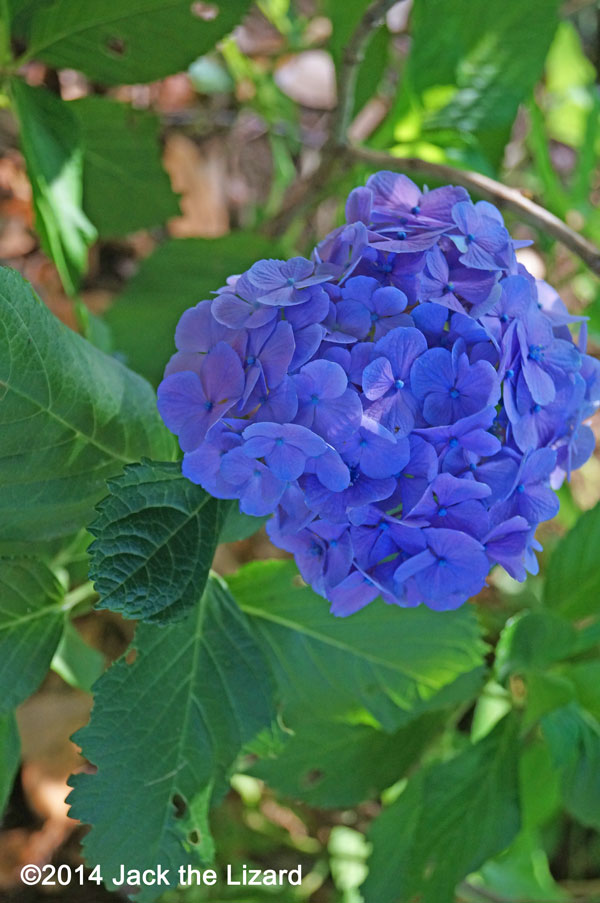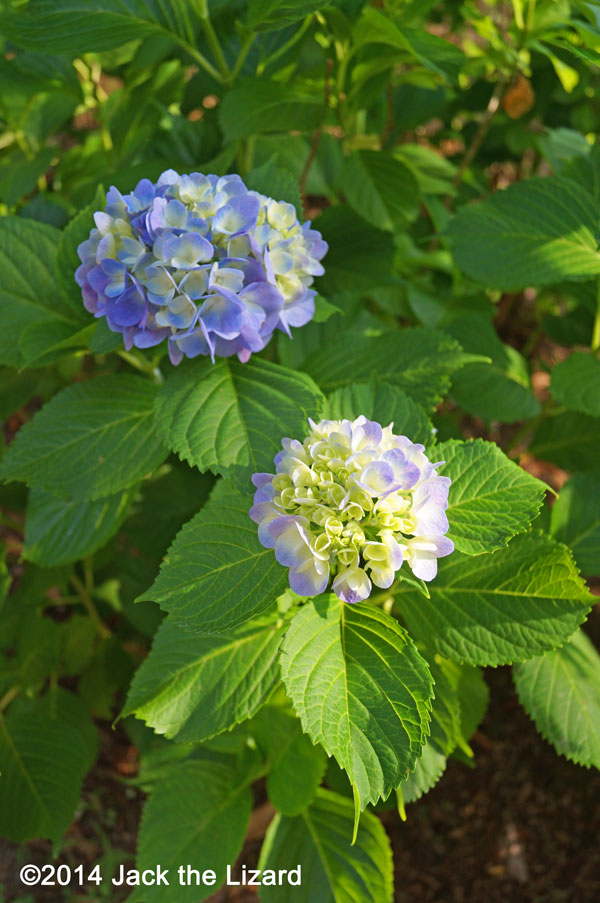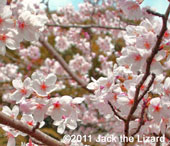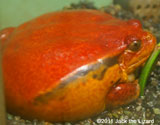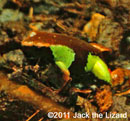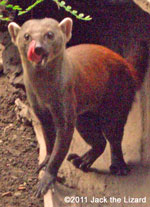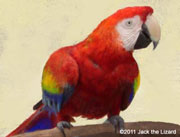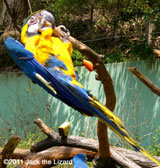
|
|
|
The book is available for download on your iPhone, iPad, iPod touch, any other e-book readers and on your computer. |
|
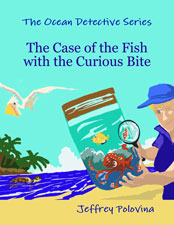
$0.99 |
from iBookstore and BARNS & NOBLE
Alexis is an Ocean Detective Agent. One day, Jake, a fisherman, visited her with a fine tuna with several circular shallow holes. Alexis starts her investigation to find out what has happened to the tuna. She asks her friend Hector the dolphin. Surprisingly, Hector says that he has the same experience that something has made a nasty bite and left a hole on his body just like the one on the tuna. It seems the mysterious creature is hiding somewhere close in the sea. What kind of creature is responsible for those nasty bites? Alexis goes to the ocean to find out. What will she encounter and can she solve this mystery? |
|
|
|
Jack the Lizard is on YouTube |

Prehistoric Animal Coloring Pages are HERE!! |
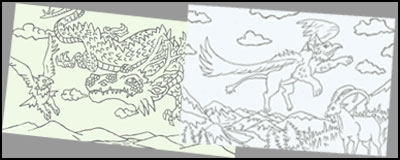
Animals in Legend Coloring Pages are HERE!! |
|
For the print size image, click |
 |
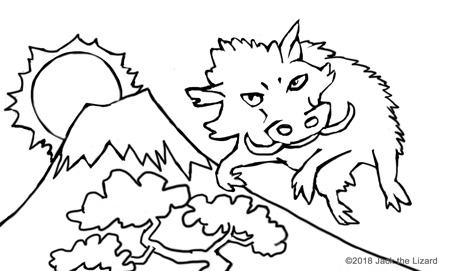
|
2019 Year of the Hog Which country has the largest population of pigs, that is China. The second is the U.S. and the third is Brazil. Probably because they eat an enormous amount of pigs, the number of pigs in China is overwhelmingly large. About 9000 years ago wild boars had been domesticated. Originally wild boars inhabited the Eurasian and European Continent and then they had been brought into North and South America. During the middle age they were served as main dish in Europe because they bred in numbers eating nuts and roots in the forest. In Japan eating meat was not custom till the Edo Era under the influence of Buddhism, but since the Meiji Era pig farming was introduced because of Westernization. Wild boars and pigs sustain human lives around the world today. |
 |
For the print size image, click |

|
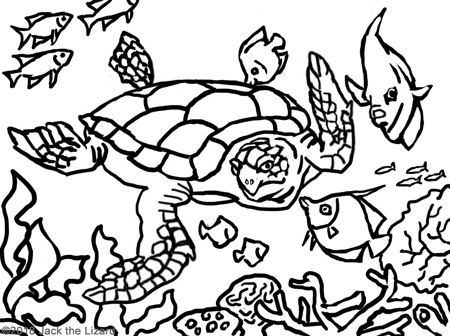
|
|
|
Travels of Sea Turtles Invasive species have a huge impact on the environment. Some species of toads have venom which affects often local species and human health. They proliferate rapidly because there are few animals prey on them in the new environment. Then they spread their range in short period of time. Human must stop their expansion to protect ecosystem of local environment. Sometimes they must be wipeout. In many cases human introduced those invasive species to the new environment. No easy answer for extermination. Tree frog and Hydrangea during the rainy season in Japan. |
Travels of Sea Turtles Most of the sea turtle species spend their time in the open ocean when they are juveniles. It takes approximately 10 years for them to return to coastal water and they continue to forage to be mature. Probably they need decades to be mature enough to mate. Throughout their life most of sea turtle species migrate vast regions of ocean around the world. No wonder why it is very difficult to research on their life cycle and protect them effectively. Also, their breeding sites covers extensive area of beaches of several countries. Like whales, sea turtles need the conservation without borders. |
|
For the print size image, click |
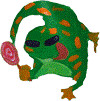 |

|
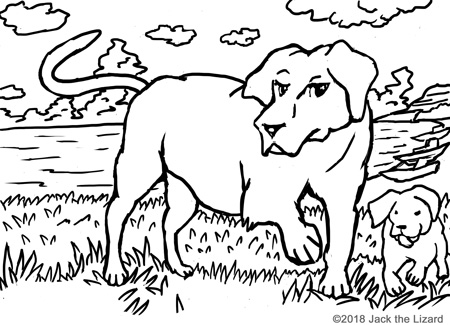
|
|
|
Gray Wolf Gray wolves live in Eurasia and North America. They are most common species among the wolf family and their range covers vast region. Since they are highly adapted to several kinds of climate, they inhabit places such as deserts, grasslands, and forests. Even they are occurred in Arctic region. Their diet is not only medium and large size of mammals, but also includes fish, frogs, lizards, and insects when the prey is scarce. They occasionally eat fruits such as melons, apples, and berries. Although they eat live stock if they could not find any other food, they will not attack humans unless they are infected with disease rabies. |
Labrador retriever at work Labrador retrievers are working dogs. Not only they work as hunting dogs, also they help police to find illegal drugs and bombs. They can truck missing person and criminals with their superb sense of smell. Their intelligence and friendly behavior are suitable for guide dogs for disabled. Although they are always good friends of humans, humans are not for them. During the war they detected and trucked enemies as well as missing soldiers. Inevitably they were killed in action with their trainers. |
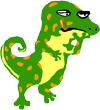
Jack the Lizard |
For the print size image, click |

|

|
|
|
Dogs always with us The Labrador retriever is the most popular domestic dog in the North America. They are from Newfoundland and Labrador, Canada. Since fishery has been the prominent industry there, fisherman took them to the sea as working dogs. Their jobs were such as retrieving fish fallen off the nets and pulling the ropes. Now a day they work at the hospital as therapy dogs and the disaster area as rescue dogs. On the other hands Shiba Inu are one of the most popular and oldest breed in Japan. Their ancestor is probably Jomon dog which lived during the Jomon period, around 1500 year-ago, in Japan. They were originally with human as hunting dogs, but now they are companion dogs most of the time. |
Jellyfish has Long History The ancient of jellyfish had appeared during the Cambrian Period, around 500 million years ago. Jellyfish is one of the animals in Cnidaria which includes sea anemone and corals. Cnidaria has poisonous spines on their tentacles with which they capture prey or defend themselves against predator. The body of jellyfish is composed of gelatin and like an umbrella in shape. Jellyfish is floating or drifting across sea or fresh water in most of their life time. Sharks and sea turtles prey on jellyfish and jellyfish are also predators which catch fish and other animals. |
|
For the print size image, click |

Jack the Lizard |
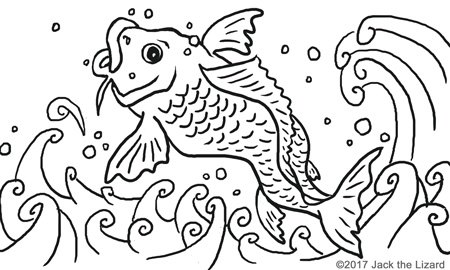
|
Ancient Chinese Carp During the Jin Dynasty in China (1115-1234) many fish figures were depicted on the back of bronze mirrors. Jurchen people who created the Jin Dynasty did fishing for living and they wished that fertility of fish promised them to have healthy children. Also the luck would be in surplus because of the pronunciation of fish and surplus is same in Chinese. Craps were often depicted because people believed that carps would be turn into dragons when they climbed up falls. 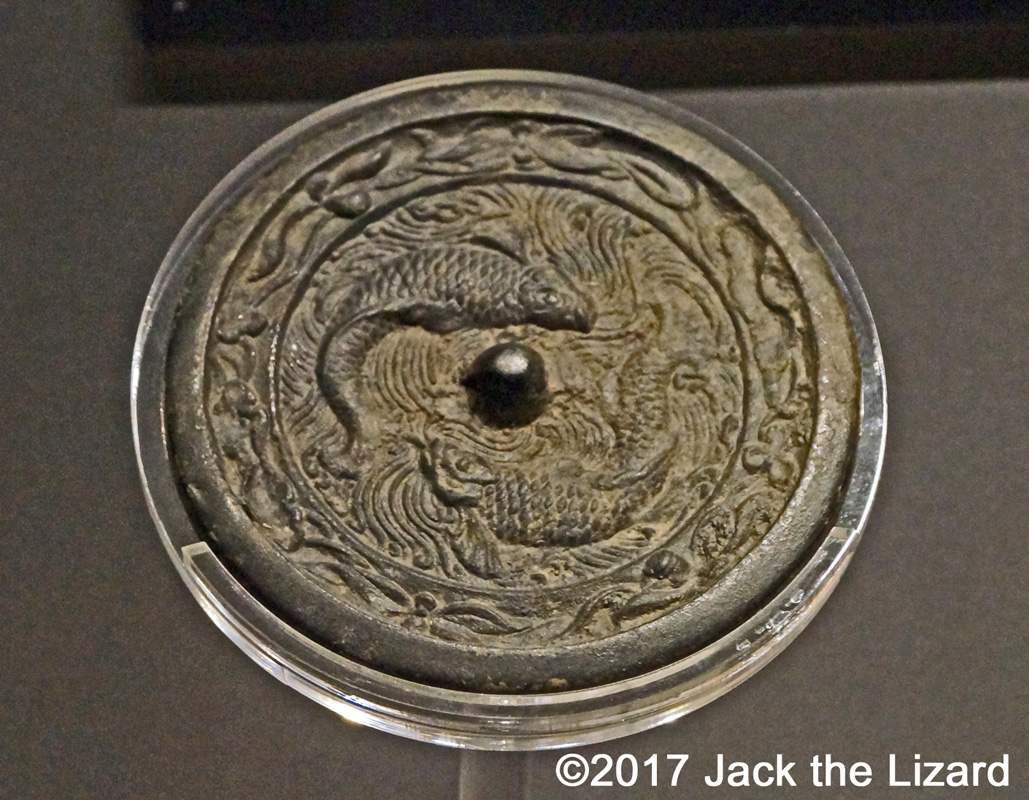 Broze Mirror with Carp Image |

Jack the Lizard |
For the print size image, click |

|
Peafowl Peafowls have three species including green, blue, and Congo. Male peafowls are called peacocks and female are called peahens. Blue peafowls live in India and Sri Lanka while Greens are found in Myanmar and Java. The distribution of Congo is the African rainforest and they don’t have large covert feather as the others do. Both Asian species likely stay in shrubs and plants around. They eat varieties of items such as seeds, plants, fruits, insects, amphibian, and small reptile. The train of peacock is for attracting peahens. Female will decide on their mate by the color, size, and qualities. |
|
For the print size image, click |

Jack the Lizard |
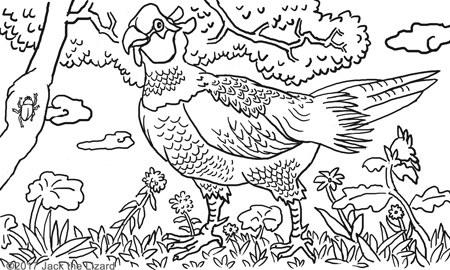
|
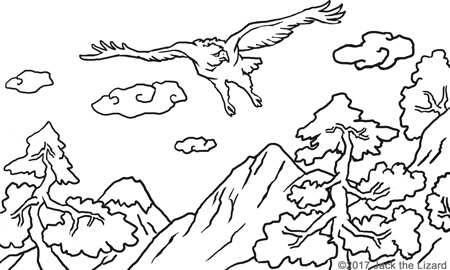
|
|
|
National Bird Some countries have their national birds. For instance Andean condor is Chile’s. Little owl represents Greek and Indian peacock symbolizes India. Green pheasant is the national bird of Japan. They are occurred in three islands such as Honshu, Shikoku, and Kyusyu. The habitats are mountains area, plains, riverbeds, and farmland. They prefer to stay open grassland Sometimes they also appear urban area and residential district. The diets are mainly plants such as shoots, leaves, and seeds, but also include insects as well. The interesting feature is that they are predict earthquake by detecting tiny vibration of the ground. |
Raptors have considerable impact on environment Raptors are valuable species in the Birds. Since they need variety of prey such as birds, small and middle size mammal, fish, and insects, they inhabit all sorts of environments such as mountains, forest, prairie, and coast. The features of birds of prey are sharp strong beaks and talons. Among the largest species of raptors is Andean Condor whose wingspan is over 3 m (10 ft). One of the smallest one such as Japanese sparrowhawk is only size of 20 cm. More than 500 species of raptors exist in the world. |

Jack the Lizard |
For the print size image, click |

|
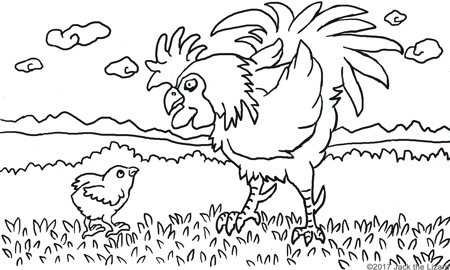
|
|
|
First Dream If you have mountain, birds of prey or eggplant in your dream on the New Year Day, you will have great year. Mountain is the symbol of idea and high achievement and birds of prey stand for strength and luck. Eggplant is called “nasu” in Japanese and nasu also means success. |
Intelligent Bird - Chicken - Chickens know so many things. They use different voices to inform other chickens of predator nearby and where they can find food. They are also social animals. It is common for them to make friends in their communities and share the information between them. You can distinguish their personality as well. Some of them are shy and some are curious. They are able to recognize human faces and memorize them. You can not fool them by hiding food, because they know the food is still there. Anticipating future is another ability of chickens. For instance if they will have more food later rather than eat now, they wait. As we know them well, we will find more of their ability. |
|
For the print size image, click |

Jack the Lizard |

|

|
|
|
African Lion is in peril African Lions have been losing their number rapidly since 1990s. People hunt loins to defend their cattle and get their body parts for medicine. As the area of cattle ranches is expanding, the environment of lions’ habitat is deteriorating, because the wild grazing animals such as wildebeest and zebras are losing their foraging ground. Some people help farmers to help lions. If lions attack their livestock, farmers will get compensation from those people. But still it is long process that the population grows back again. |
Dugong need the protection Dugongs are found in warm body of sea water, such as coasts of Southeast Asia, Australia, India, and east coast of Africa. Most of their food is sea plants and without them dugongs hardly survive. Dugongs and manatees are closely related, but the shape of their tail is different. Manatees have round shape one, on the other hand dugongs have the tail like whales’. Like manatee dugongs are peaceful plant-eater, but or as they are, they were hunted for their meat and oil by humans. Their ancient relative stellers’ sea cows were extinct because of over hunting. Now dugongs are protected species all over the world, but the population is still vulnerable because dugongs reproduce very slowly and the degradation of sea such as disappearance of sea grass meadow threats them. |

Jack the Lizard |
For the print size image, click |
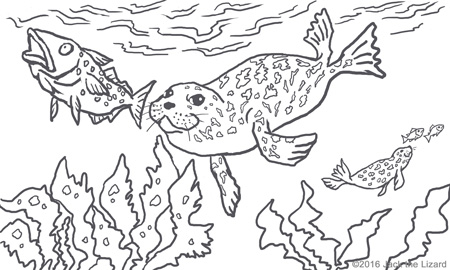
|
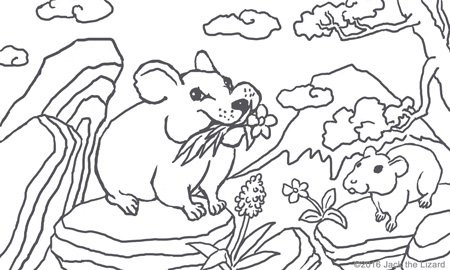
|
|
|
Spotted Seal Spotted seals occur in the Bering Sea, Okhotsk Sea, the Sea of Japan, and other part of North Pacific Ocean. The size of a spotted seal is about 4.5 to 7ft (1.5 to 2m) long. The habitats are arctic and sub-arctic region of cold water zone. From March to April a female give birth to a pup on ice floes. Because of rearing a pup on the ice, spotted seals absolutely need ice floes to reproduce stably. They eat a variety of fish such as herring, cod, salmon, and pollock. Also crustaceans, octopuses, and squids are on their menu. On the other hand polar bears, Orcas and sharks hunt spotted seals. Humans also catch spotted seals for their fur. The life spun is about 30 years. |
Sweet Home Crevice - Pika - A Pika is a small animal of which size is about 4.5 to 8 inches (12 to 20cm) long. Despite they have short eras and limbs they are relative of rabbits and hares. The main habitat of Pikas is a mountain area because they adapt to cool temperature. Some species also live in grasslands. They are distributed in North America, Eastern Europe, and East Asia. Crevices of rocks are used by pikas as burrows. Some species of pika share their burrow with other pikas, ground squirrels and birds. Pikas are plant eaters and need to store hays for winter because they do not hibernate. In the summer they are busy to collect and eat plant matter during the daytime. Pikas are known as having variety of calls to alarm and attract mates. The global climate change threats pikas’ survival because pikas are vulnerable to heat. |
|
For the print size image, click |

Jack the Lizard |

|

|
|
|
Let them alone - Hedgehog - A Hedgehog is of course not a big. I t is closer to a mole. There are 17 species of hedgehog in Africa, Europe, and Asia. European hedgehogs are most popular among them. The size of a European hedgehog is about 10inches (25cm) long. The habitats of European hedgehogs are varied such as woodlands, grasslands, and even man-made environment such as gardens and parks. They mainly eat slugs, earthworms, and insects but also occasionally have some fruits and mushrooms. The spines of their body drive most of predator away, but they are vulnerable to eagles and owls. They are nocturnal animal and have solitary life. They do hibernate during the winter. Although companion hedgehogs are hybrid species, they also enter to the state of hibernation under rearing condition. The hibernation is too stressful for companion hedgehogs and they eventually die of starvation if an owner failed to take care of them. After all they are not suitable as a pet because they are extremely sensitive for temperature. |
Flying Squirrel Flying squirrels use a hollow of a tree as their den. They are very shy animals and stay in their den during the day. In the twilight they start collecting food and gliding from a tree to another. They have membranes between their hands and legs and catch the wind with them when they glide. If they received strong wind, they are able to fly as long as 55 yards (50m). Their diets are mostly vegetables such as barks of trees, buds, leaves, flowers, and nuts. Even in the winter they are quite active and not going to be state of hibernation. Instead of storing food as chipmunks do they eat lots of hi fat food before winter comes. |

Jack the Lizard |
For the print size image, click |

|
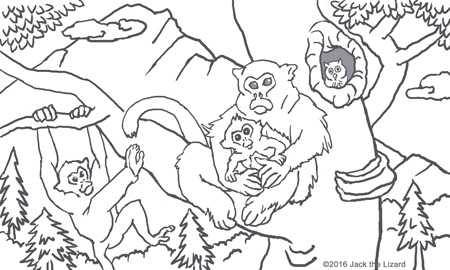
|
|
|
Cute little beast of prey - Weasel - Weasels are the smallest species in the family of Mustelidae including otter, marten, mink and ferret. The size is 7inches (18cm) more or less. In spite of their size they are fierce predator and able to hunt prey that are larger than themselves. The prey items are varied such as rabbits, mice, voles, frogs, and insects. They are active during the night and sleeping in their den in the daytime. The back side of color is brown and belly side is white during the summer and whole fur turns into white in the winter. The habitat extends all over the world except Australia and the polar region. |
Golden Monkeys live high altitude Golden snub-nosed monkeys live in mountain area of central and Southwest China. They spend most their time on trees and eat lichens. The elevations of their habitats are very high about 2000m. It gets much snow and colder during the winter, while they are adapted sub-zero temperature. No other primates except humans and Japanese macaques are able to with stand such cold temperature. The long golden fur protects them from cold, but it also attracts hunter. Loss of habitats threats their survival as well. The predators are such as red dogs, wolves, Asian golden cat and leopard. Goshawks also attack juveniles and gold eagles are menace to even adults. |
|
For the print size image, click |

Jack the Lizard |
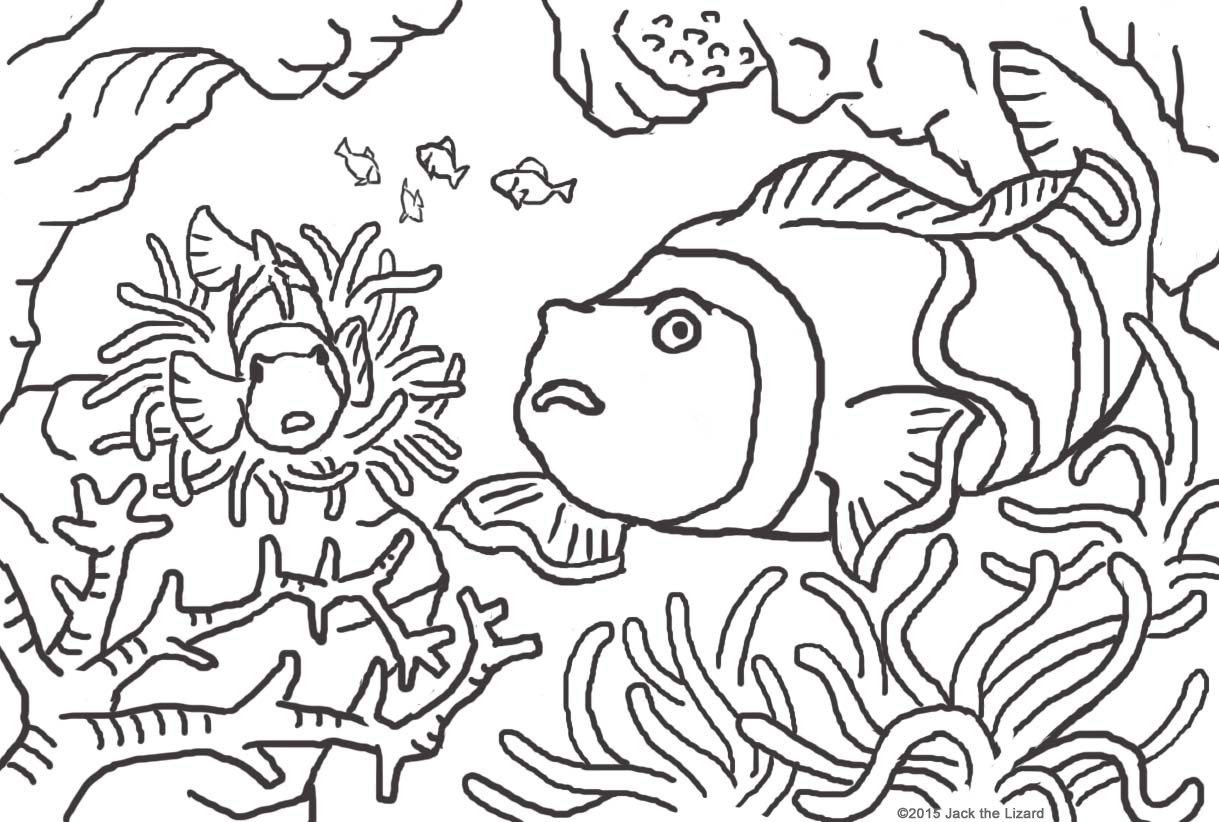
|
Crown Fish Anemone fish or Clown fish always hide among the tentacles of sea anemones. Although the tentacles of anemones have stings with venom, clown fish don’t get hurt because they are protected by their mucus which is thin film of slime. Therefore the forest of tentacles provides clown fish a shelter against predator. Anemones also get benefit from clown fish by feeding on the leftover of clown fish. Clown fish protect anemones as well by driving away anemone eater such as butterfly fish and mosshead sculpins. Certain fish such as cardinalfish and anemone goby and shrimps also have a life with anemone. 
|

Jack the Lizard |
For the print size image, click |

|
Pennant coralfish (Coral Fish Series) Pennant coralfish or longfin bannerfish are tropical fish and live in lagoons, channels, and reef slope. They grow up to 25 cm (9 in.) In the wild they mostly eat plankton. By eating parasites, Pennant coralfish, especially juvenile, clean skins of other fish and sea turtles. For themselves they produce the mucus from their skin to be parasites and germ free. They are social fish and unusual for them to defend their territory. 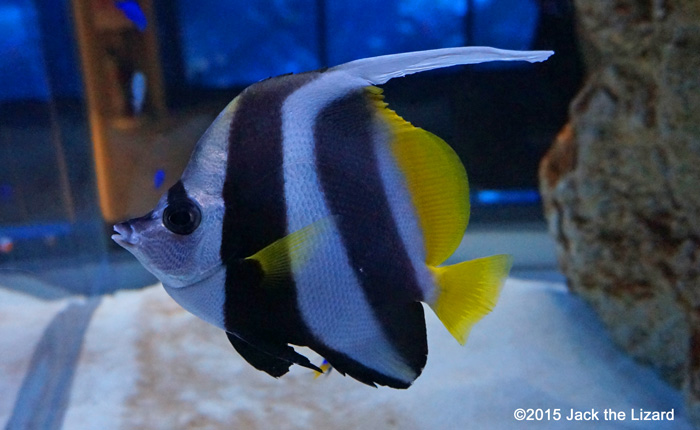
|
|
For the print size image, click |

Jack the Lizard |
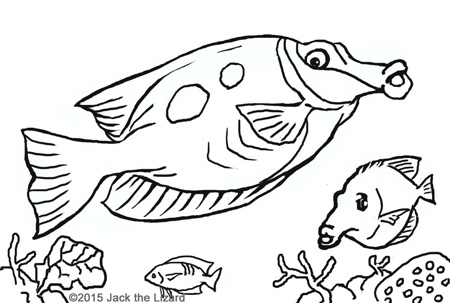
|
Blotched Foxface (Coral Fish Series) Blotched foxface belong to the family of rabbitfish. The range is tropical water of the western Pacific. Usually they are found in corals or rocky places with seaweed. They are peaceful fish and active during the day. Some form a school while others swim individually. As they are omnivore their diet are algae growing on the rock and zooplankton. 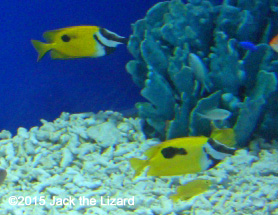
|

Jack the Lizard |
For the print size image, click |
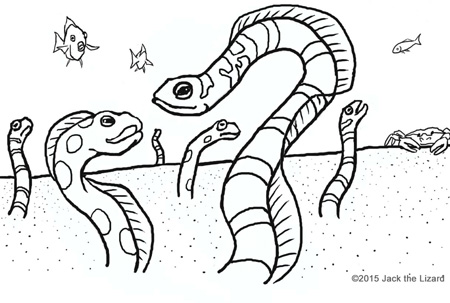
|
Splendid Garden Eel Splendid garden eel are found in tropical water of oceans. The size is up to 40 cm (16 in.) in length and about 10 mm (0.4 in.) in diameter. They live in a small size of group or individually in the sandy place. Usually they stick out head and body from the sand. In this position they wait for current to bring plankton into their mouth. When they feel danger, they retreat into the sand for safety. They have white stripes on yellow skin. The family of garden eel has various colors. They secrete slime to prevent their burrow from collapsing. 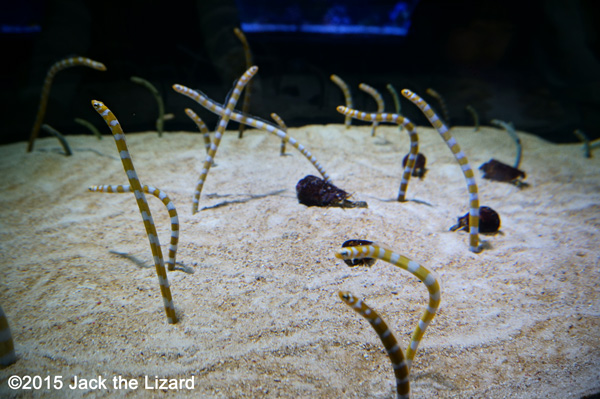
|
|
For the print size image, click |

Jack the Lizard |
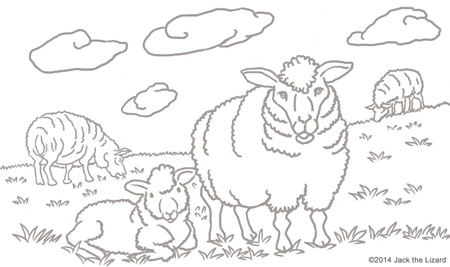
|
Animal of Fortune The Japanese kanji symbol ”羊”, which means sheep, was used for the first time in China around 3000 years ago. Some study shows that the symbol of sheep is similar to the symbol of fortune “祥” in ancient China. Therefore sheep is considered as the animal brings fortune. The symbol of beauty “美” also means delicious meal. Since sheep meat was exquisite feast for ancient Chinese people, the symbol of beauty is composed of the symbol of sheep. Now approximately 1300 species of sheep exist, including 200 breeds of domestic sheep, around the world. Wild sheep mostly inhabit mountain area because predators are not able to reach there. Both wild and domestic sheep live in a flock. Living in a flock makes it hard for predator to catch one. Sheep was highly valuable livestock in the ancient Middle East and the flock was the symbol of wealth. |

Jack the Lizard |
For the print size image, click |

|
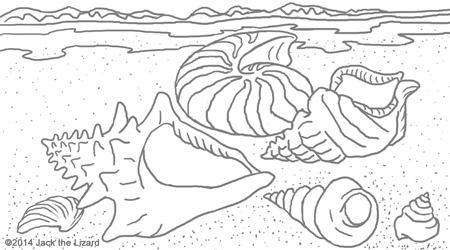
|
|
|
Sustaining Human Life - Sheep - Sheep were domesticated around 8000 B.C. The ancestor of sheep is probably wild mouflon ranging over Iran, Iraq, and the Caucasus. Although sheep do not have strength to pull agricultural equipment and bring heavy load, they were the most important livestock for their fleece, milk, and meat in ascent world, especially within the Indo-European language region the livestock was sheep. Following their leader and forming flock are the characteristic behavior of sheep. They are herbivore and graze on grass during the day. Sheep are usually docile and gentle animal, therefore herding dogs are able to move the flock without difficulty. |
Soft Body Make Hard Shell Seashell is outer skeleton of an invertebrate (an animal have no backbone) such as marine mollusks. Seashells that are commonly found at beach are shells of bivalve and gastropods. Some cephalopods such as Nautilus also form shell. Seashells are made of protein and calcium carbonate and covered with chitin. Most of invertebrates have only soft body. Therefore they use seashells for protection and shelter. Other ocean animals such as helmet crabs and small octopuses use seashells for their home and protection. Mollusks tend to form colorful seashells in tropical and sub-tropical oceans. Some seashells are beautiful in color and shape and sold as souvenir and ornament. Unfortunately these commercial trades sometimes take too many of seashells and kill animal inside. |
|
For the print size image, click |

Jack the Lizard |
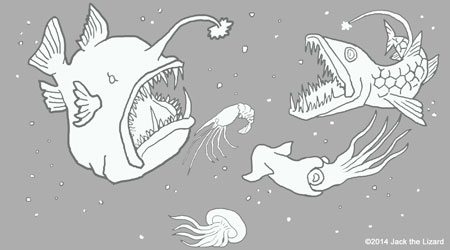
|

|
|
|
Bio Light - Angler Fish - Not only coral reefs in warm oceans have colorful fish and sea animals but also cold seas have luminous community. Anemones have almost all sorts of colors and their ranges expand from the Polar Regions to the tropics. Sponges are also found worldwide and have varieties of colors and shapes. Starfish feed on anemones and sponges, naturally they coinhabit at the bottom of the oceans. The colors of starfish range from orange, yellow and red, to brown and purple. Sunflower starfish grow up to over 3.3ft (1m) in diameter. Red king crabs are used to live in the Bering Sea and Sea of Okhotsk but they introduced in the ocean of Norway by human hands. Red king crabs also expand their habitats to Antarctica, because of the climate change. This crab has voracious appetite and heavily armored body and few predators. It could turn colorful gardens to mono torn deserts by gobbling up sea anemones, sponges, starfish, and other animals in the cold water oceans. |
Colorful Cold Water Sea Not only coral reefs in warm oceans have colorful fish and sea animals but also cold seas have luminous community. Anemones have almost all sorts of colors and their ranges expand from the Polar Regions to the tropics. Sponges are also found worldwide and have varieties of colors and shapes. Starfish feed on anemones and sponges, naturally they coinhabit at the bottom of the oceans. The colors of starfish range from orange, yellow and red, to brown and purple. Sunflower starfish grow up to over 3.3ft (1m) in diameter. Red king crabs are used to live in the Bering Sea and Sea of Okhotsk but they introduced in the ocean of Norway by human hands. Red king crabs also expand their habitats to Antarctica, because of the climate change. This crab has voracious appetite and heavily armored body and few predators. It could turn colorful gardens to mono torn deserts by gobbling up sea anemones, sponges, starfish, and other animals in the cold water oceans. |

Jack the Lizard |
For the print size image, click |

|
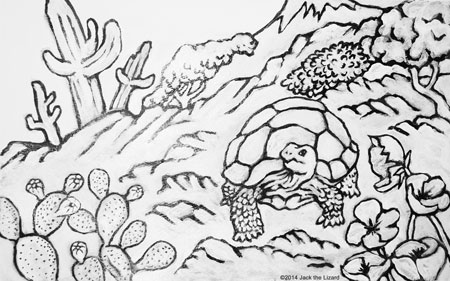
|
|
|
Miracle Seed - Sunflower seeds - Many species of birds love eating Sunflower (the common sunflower) seeds. Raw sunflower seeds include many nutrients such as protein, fat, and iron. The sunflower seed with black coat is used for the oil production and the striped sunflower seed is for the food. Although most of seed eating birds prefer sunflower seeds, some of them have difficulty to crack the husk of striped sunflower seeds to reach kernel inside. Therefore these small birds such as finch prefer black-oil sunflower seeds. Relatively larger birds such as blue jays even eat it whole. When bird-lovers place the bird feeder to attract wild birds, sorts of sunflower is the first ingredients of mixed seeds. Some small birds such as cardinals and finch are so choosy that they try to find sunflower seeds in mixed seeds. |
The Home is Desert - Desert Tortoise - Desert tortoises range over southeastern California, northwestern Arizona, and northwestern Mexico. Since they are able to store water in their body and dig underground burrows to escape from heat, they can survive extremely dry environment with temperatures exceeding 140 °F (60 °C). The used burrows are recycled by other small animals such as antelope squirrels, burrowing owls, rattle snakes, and gila monsters. Therefore desert tortoises help the area they live in increases biodiversity within. Desert tortoises are active in spring when they can forage the most of their food such as flowers, grasses, and cacti is available. The population of desert tortoises in the Mojave and Sonoran desert is approximately 100,000. Thus it is illegal to touch, harass, or collect desert tortoises in the wild. For more stories about Desert tortoise, click HERE!! |
|
For the print size image, click |

Jack the Lizard |

|
Tiny but lethal bite - Blue Ringed Octopus - The blue ringed octopuses are found in warm oceans from Japan to Australia. They inhabit sandy or coral reefs of shallow water area. Although they are tiny octopuses, the size is about 5 to 8 inches (12 to 20 cm), they could kill adult humans with their powerful venom. When the blue ringed octopuses are calm and relax, their skin color is blue rings on yellow base. Once they are disturbed the color changes dramatically, yellow skin turns to brown and blue rings get brighten. Despite their cute appearance, the blue ringed octopuses are formidable predator. They mainly prey on crabs and shrimps. Once they seize the prey they break outer skeleton of prey with their beak and inject venom inside. Since the meat inside is partly melted with venom, they can easily suck out the flesh. |
|
|
The venom of the blue ringed octopuses has similar components with that of poison dart frogs and puffer fish. If a human was bitten, severe consequences such as heart failure and respiratory difficulty would be expected. Sometimes the victim loses their life from suffocation within a few minutes. It is quite interesting that the blue ringed octopuses do not die with their own venom because their toxin is produced by bacteria which live in their saliva. Probably they have developed immune system by living with the bacteria in the course of evolution. The vaccine for human against their venom is not developed yet though. When you find the blue ringed octopus, just observe from distance with a swimming goggle and never touch it! |
||

Jack the Lizard |
For the print size image, click |
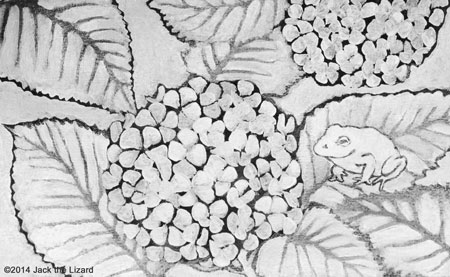
|
|
|||
|
||||
|
For the print size image, click |

Jack the Lizard |
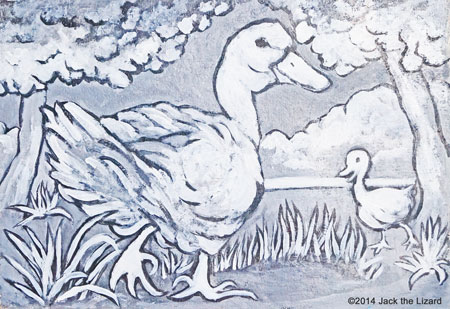
|
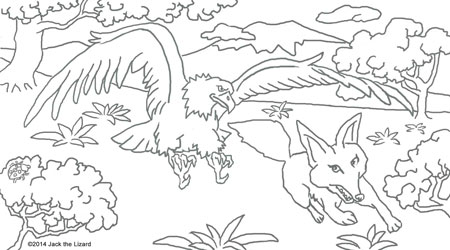
|
|
|
Water is Necessity - Domestic Ducks - Ducks were domesticated about thousands years ago in Southeast Asia. Nowadays they are mostly raised in China for their meat, eggs and down. Ducks are also reared as pets in some countries. The ancestor of domestic ducks is the common mallard or wild duck of which range is the temperate and subtropical regions worldwide. Mallards dabble to feed in water. For health of ducks water is also critically needed. Since ducks eat aquatic plants. insects, small fish, and amphibians such as frogs, they also dabble. Therefore their body is upside―down when they are feeding. While water attracts not only aquatic birds but also predators such as foxes, raccoons, and hawks. To protect ducks human should prepare the barns or shelters. |
Terror from the Sky - Golden Eagle - Golden eagles spread their range worldwide. Although their habitats are deteriorated by increasing human population and development for housing and agriculture, they are still found in North Africa, Eurasia, and North America. The Golden eagle hunts not only medium size mammals such as deer but also carnivores such as foxes, weasels, martens, and rarely bobcats. Especially foxes are important diet for them. These carnivores also compete with golden eagles for prey such as rabbits, rats, and mice. In Japan the population of golden eagles declines significantly because they cannot find proper nesting site and enough food to bring chicks up. |

Jack the Lizard |
For the print size image, click |

|
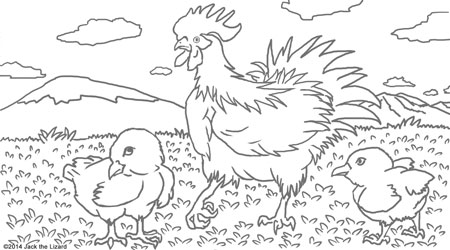
|
|
|
Blue Bird Near By Three species of blue birds are found in North America. Eastern bluebirds live in East side of the Rocky Mountains from Canada to Mexico and westerns are found in west side. Both species have blue wings with a reddish brown breast. They can be found at back yard and parks. Mountain blue birds also live in west, but their range is usually above 7000 ft (about 2000 m). However they were declined because of invasive species such as house sparrows and starlings. As those birds take over the nest of bluebirds and then kill chicks and adult bluebirds. However bluebirds are coming back with help of many volunteers who care this bird. Bluebirds use cavities of tees or box as their nest. Usually two to four eggs are hatched during the spring and summer. Predators such as snakes and raccoons are threats for chicks. Bluebirds are insectivore, but they also eat fruits such as berries and wild grape. You don’t have to look for far away. Bluebirds are always nearby. |
Chicken We Know Chickens are social birds that live together in flocks and have their own hierarchy. They can actually fly, but not for long distance. Usually they flee when they notice some danger surround them. In the wild chickens are omnivores they eat plants, insects, and small animals such as lizards. Chickens can be good companions as pets. Hens are tamed when they are properly handled, but roosters are sometimes aggressive. A rooster crows to warn danger to his flock or signal his territory against other roosters. Interestingly a rooster encourages other chickens to eat first when he finds food. Also mother hens give food to their chicks first. Chickens are very curious. They explore their surroundings and naturally they roost on trees to look over. They are also taking a dust bath to clean their feathers and remove parasites. Chickens can live for about 5 to 10 years. |
|
For the print size image, click |
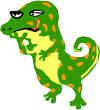
Jack the Lizard |

|

|
|
|
Resistant Cat - Leopard - The range of leopards is mainly Africa. They also live in south East Asia and India. Although leopards principally stay in savanna and rainforest, they also adapt to life in temperate forest and semi-arid desert area. Leopards associate with trees in which they eat, rest, and sleep. Sometimes trees give them refuge from lions and hyenas. Since leaves and branches cover a figure of leopard, preys such as impala and velvet monkeys cannot notice the presence of hazard above. Diversity of leopards’ diet is one of the reasons why leopards successfully survive in variety of environment. Leopards eat insects, fish, amphibians, reptiles, birds, and mammals. They are good climbers and swimmers. They are also able to bring the prey heavier than themselves to up in a tree in which they eat their prey undisturbed. Leopards avoid predators such as lions, hyenas, tigers and bears. Not only those predators steal prey from leopards but they kill leopards and occasionally eat them. |
Pair sings along - Crane - The crane is considered as lucky bird in many countries. In ancient Rome cranes were worshiped because of their ability of flying high. Since cranes can fly over the top of Himalaya, they have been also regarded as a spiritual bird in Asia. Cranes are monogamous so a pair of cranes may stay together for the rest of their life. Therefore the bond of crane pair symbolizes the long term relationship. In addition cranes use many different calls to communicate each other. Especially a couple uses their original duet call when they breed. Since cranes have large territory during the breeding season, the call of cranes which is so loud and clear can reach miles away. People believed that the crane call could get to heaven in China. |

Jack the Lizard |
For the print size image, click |
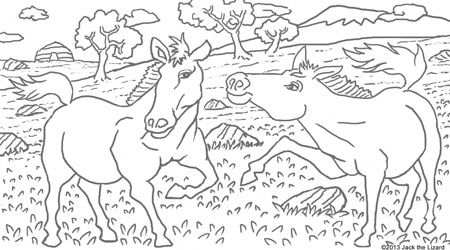
|
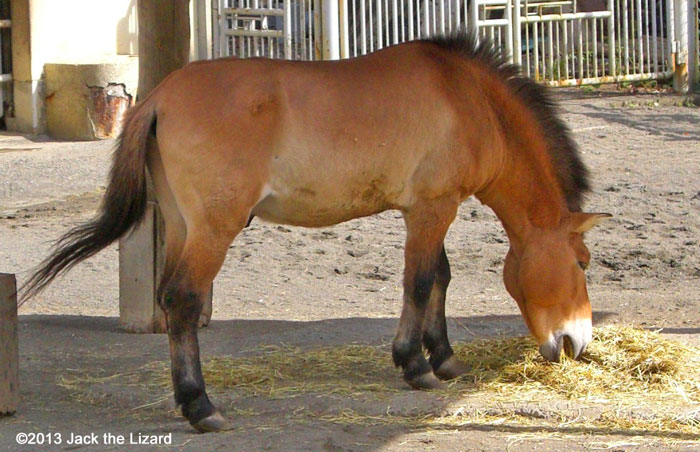
|
|
|
True Wild Horse Today - Przewalski’s Horse - Regrettably wild horses in the U.S. and Australia are not truly wild. They are offspring of domesticated animals which escaped and stayed in the wild. Besides zebra and wild ass Przewalski’s horses are the only truly wild horses in the world. Whereas they were once extinct in the wild during the late 60’s, some of them were survived in captivities. They were reintroduced into their natural habitat in Mongolia. The population has been increasing since then in the wild and the number is approximately 300 now. |
||
|
For the print size image, click |

Jack the Lizard |

|

Jack the Lizard |
For the print size image, click |

|

|
|
|
Japanese raccoon dog There are two types of the Japanese raccoon dog, Ezo living in Hokkaido and Hondo living in Honshu, Shikoku, and Kyusyu islands. Although both of them are subspecies of the raccoon dog, only Ezo Japanese raccoon dogs hibernate. Instead Hondo increase fat rate in their body by eating as much as food during fall to prepare winter cold. Since they are omnivore their diet are varied such as insects, frogs, rodents, fruits and plants. Usually they stay in forests but recently some of them are adapted to urban life as well. Japanese raccoon dogs are active during the night and live individually or a pair in the forest. The pair stays together for the rest of their life. Their fur is consisted with two layers, outer layer has hard long hairs which protect their body in the bush and second layer has thick soft ones which keep their body warm. With membrane between fingers they are able to move themselves without difficulty in a marsh or swampy places to find water bugs, fish, and other aquatic animals. The feces are reserved one place by which Japanese raccoon dogs probably exchange information each other. They are so timid that they feel threats they do “fox sleep” to disguise natural enemy. In Japan they are called “Tanuki” and believed to be canny animal or bring fortune. When you have opportunity to visit Japan, you may find their sculpture with huge berry. |
Red fox and Autumn Red foxes are designated as one of the worst invasive species in IUCN’s list. However it is unfair to blame on them because they were introduced to Australia in which they are threat for native mammals and birds by humans. Red foxes are the largest of all fox species. They are originally native to North America, Asia, Europe, and North Africa. Red foxes primarily feed on small animals such as voles, ground squirrels, pocket gophers, raccoons, and opossums. Also they take reptiles, fish and insects. On the other hand golden eagles are one of the predators who assault and eat red foxes even though they are lighter than red foxes. In Africa and south west Asia Golden jackals dominate red foxes in the area where both territories are over rapped. Whereas most of these predators are carnivores, red foxes are omnivores. Therefore red foxes eat mainly fruits such as blueberries, raspberries, apples, plums, and grapes in autumn if those fruits were available. |
|
For the print size image, click |

Jack the Lizard |
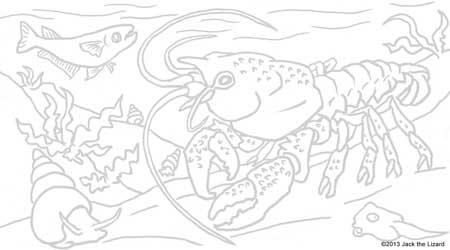
|
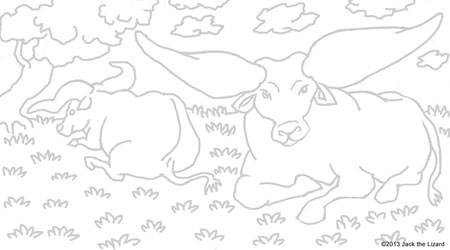
|
|
|
Red swamp crawfish Red swamp crawfish originally live in Southern United States and Northern Mexico. Since red swamp crawfish are omnivores, their diets are varied such as water plants, aquatic insects, tadpoles and small fish. They are also scavengers and cannibalistic when food is scarce. During the day they dig their burrow into mud and stay in. If it gets too cold, they hibernate during the winter time. Sometimes their burrowing activities interrupt water flow into paddy field. They also damage crops by eating its roots. The water ecosystem is disrupted as well because their voracious appetite decreases biodiversity in the water. Red swamp crawfish are delicacy in some countries such as United States, China and Australia. In Louisiana they are consumed most and crawfish farming flourishes as well. However the commercial harvest of red swamp crawfish grows in other countries such as China, Kenya and Spain. |
Watusi the great horns The Ankole-Watusi is a breed of cattle who has the largest horns of all cattle breed in the world. Originally from Africa the habitats of this animal are the savanna and glass lands. The roles of huge horns that can grow up to 8ft (2.4m) are defense and controlling its body temperature. Since the Ankole-Watusi can survive on limited food and water source environment, several tribes of Africa rear the animals. |

Jack the Lizard |
For the print size image, click |

|
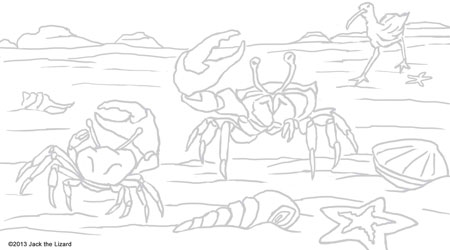
|
|
|
I can see you - Great Hammerhead Shark - Great hammerhead sharks seem to live in warm water of oceans worldwide. Although they often found at coral reefs, they also swim into deep water and migrate. The preys are varied such as crabs, squids, octopus and several kinds of fish. Great hammerheads also feed on other smaller sharks and their own kind. They grow up to about 20ft(6m) long and once they reach maturity there are no predator threaten them. Although Great hammerheads eat several preys they prefer to hunt rays. They use their wide heads to sensor the electricity emitted by rays hiding under sands. Once they detect presence of a ray, they pin down a ray with their heads and eat ray’s fin first to imimmobiliset. The population of Great hammerheads probably declined in the world and IUCN (International Union for Conservation of Nature) designated them as endangered species. Considerable reasons are overfishing for their fins, which is expensive ingredient of shark fin soup and bycatch of fishing nets. Great hammerheads are potentially danger to human, but not many fatal attacks are recorded. |
Tiny Ocean Violinist - Fiddler Crab - Chipmunks live in North America. Since their diet consists with both plants and meats, they are omnivorous animal. They eat seeds, nuts, fruits, grass, shoots and flowers. Also they eat mushrooms, insects, frogs, and bird eggs. To prepare for winter they collect food such as acorns and hazel nuts. They have cheek pouches to carry those foods to their nests for storage. Some of them spend their time in their burrow and others hibernate during winter. Chipmunks are contributed to healthy forest ecosystem. Since chipmunks sometimes forget their hiding places for their foods, they spread seeds all over forest. Then trees can disperse their offspring by chipmunks. When chipmunks eat fungi, spores of fungi attach the body of chipmunks. Then the spores are transferred by chipmunks. Diversity of trees and fungi depend on chipmunks. Animal diversity also depends on chipmunks. Variety of predators both birds and mammals catch chipmunks. Chipmunks live about only 3 years. But they take important role for the Earth. |
|
For the print size image, click |

Jack the Lizard |
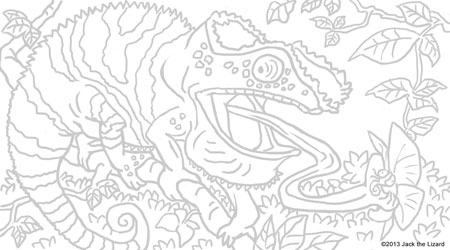
|

|
|
|
Panther Chameleon Now there are about 160 species of chameleons in the world. Most of their species are found in Madagascar and Africa. Few of them are also found in India, Sri Lanka, and southern Europe. Some chameleons are introduced in some states of the U.S.A. such as California, Florida, and Hawaii. They comprise one of lizard groups thus they like warm place. Chameleons change their skin color not only to blend into their surrounding environment but also for several reasons. The colors are varied with temperature and their emotions too. They tend to be darker color when they are angry and try to intimidate enemies. They are usually lighter when they want to attract females. The diets of chameleons are composed of both animals and plants. Sticky long tongue is longer than its body length. Although they move slowly, they are able to project their tongues very rapidly, less than 0.01sec. Most of their prey is insects, but large ones also prey on lizards, frogs and birds. Some chameleons also eat leaves, roots, and fruits. The Panther Chameleon is one of the most popular chameleons among chameleon species. Panther Chameleons live in a tropical forest of eastern and northern Madagascar. Average length of male panther chameleons is about 17in (45cm) and females are smaller. Their coloration changes along with where they live. Males are more colorful than females. There are several color variations such as vibrant blue, green, red, orange, and pink. |
Short life, Huge role - Chipmunk - Chipmunks live in North America. Since their diet consists with both plants and meats, they are omnivorous animal. They eat seeds, nuts, fruits, grass, shoots and flowers. Also they eat mushrooms, insects, frogs, and bird eggs. To prepare for winter they collect food such as acorns and hazel nuts. They have cheek pouches to carry those foods to their nests for storage. Some of them spend their time in their burrow and others hibernate during winter. Chipmunks are contributed to healthy forest ecosystem. Since chipmunks sometimes forget their hiding places for their foods, they spread seeds all over forest. Then trees can disperse their offspring by chipmunks. When chipmunks eat fungi, spores of fungi attach the body of chipmunks. Then the spores are transferred by chipmunks. Diversity of trees and fungi depend on chipmunks. Animal diversity also depends on chipmunks. Variety of predators both birds and mammals catch chipmunks. Chipmunks live about only 3 years. But they take important role for the Earth. |

Jack the Lizard |
For the print size image, click |
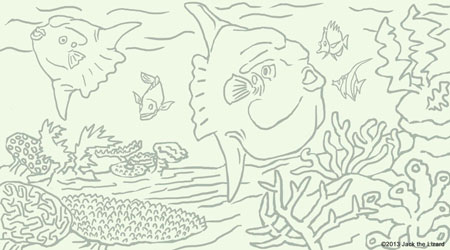
|
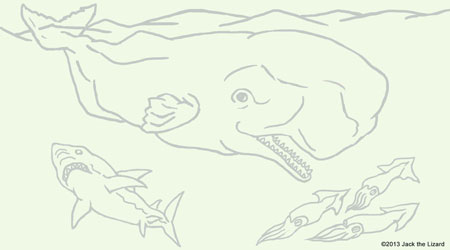
|
|
|
- Ocean Sunfish - Ocean Sunfish or common mola live in tropical and temperate oceans around the world. So far the largest ocean sunfish is 14ft (4.2m) long and 5100lb (2300kg) in weight. An adult is approximately 8.2ft (2.5m) in length and weighs about 2200lb (1000kg) in average. Ocean sunfish are the heaviest known bony fish in the world. The heaviest fish is probably whale shark, but their internal skeleton does not have hard bone. The skin colors of ocean sunfish vary from brown to silvery-grey or black; some have various spots on their skin depend on the region. They are also able to change their color from light to dark when they are under attack. Ocean sunfish are gentle fish and not aggressive toward human. Ocean sunfish are annoyed with parasites. There are about 40 species of parasites reside on the skin and body of ocean sunfish. To remove those noxious dwellers ocean sunfish get some help from small fish. They also surface to seek sea birds that clean their skin. The main diet of ocean sunfish is jellyfish, but they also intake squids, crustaceans and small fish. Few predators hunt ocean sunfish such as sea lions, killer whales and sharks. Ocean sunfish produce incredibly numerous eggs to continue their offspring. Female lays about 300 million eggs at a time. This is the largest in known vertebrate. |
Deep Sea Hunting - Sperm Whale - Sperm whales need massive food to survive. One adult eats approximately 900kg of marine animals per day. Most common diet is squids, but they also eat various fish, rays, and octopus. The prey of sperm whales includes incredibly large animals such as Antarctic squids of which maximum size is 46ft (14m) and megamouth sharks which grow up to 18ft (5m). Hunting ground of sperm whales is the deep sea. They dive as deep as 3300ft (about 1000m). Average size of male sperm whales is 52ft (16m) and female is 40ft (13m). Even females are larger than great white sharks of which adults approach 20ft (6m) in length. The life span of sperm whales is about 70 years. |
|
For the print size image, click |

Jack the Lizard |
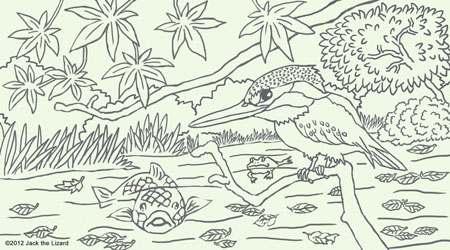
|
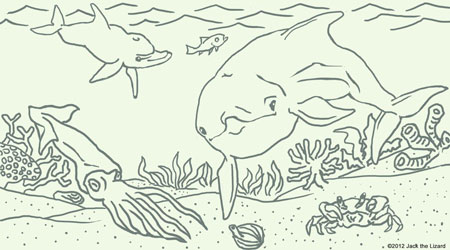 Another coloring of Dolhpin, click HERE!
Another coloring of Dolhpin, click HERE!
|
|
|
River Treasure - River Kingfisher - River Kingfishers range over South East Asia, India, Europe and North Africa. They stay their habitat unless rivers or lakes do not freeze in winter. A river kingfisher is slightly larger than a sparrow. Their heads and wings are turquoise blue and bodies are orange. The beak is dark blue, but the lower beak of female is red. There are white parts on under neck and back side of their head. River Kingfishers live in near lakes, rivers and estuaries with banks and woods. They catch fish, crayfish, frogs and aquatic insects. Usually from the branch hanging over shallow water they dive to seize their prey. They burrow the nest into the bank and rear young birds. Since they need clear water which can sustain many fish and other aquatic animals, they are good indicator of healthy ecosystem. Nevertheless they can adapt to urbanized environment. As long as they can catch their pray and breed. |
Bottle nose dolphins care each other There are 33 species of dolphin that inhabit oceans worldwide and four species of river dolphin that live in fresh water. The largest of oceanic dolphins is the killer whale (orca) and one of the most commonly recognized dolphins is the bottle nose dolphin. Bottle nose dolphins reside in temperate and tropical oceans all over the world. Some populations live in closer to the coast while others inhabit offshore. Offshore populations migrate in a season. Bottle nose dolphins live in the group called the pod that is generally consisted of 2 to 6 individuals. Males are usually live alone, but they form alliances when they compete for mating. Therefore members of pods are usually females and their offspring. Usually mother dolphins give birth to a single infant. Mothers stay with calves for 2 to 6 years. Bottle nose dolphins eat fish, squids and crustacean such as shrimps and crabs. They have good eyesight and their eyes can move independently of each other. Their hearing is also well developed and they use it for echolocation during hunts. Although they have poor or no sense of smell, they do have sense of taste. Even though they swallow fish without chewing, they prefer certain fish to other. |

Jack the Lizard |
For the print size image, click |
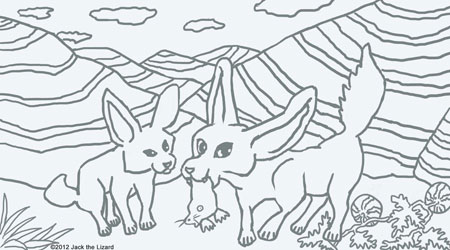
|

|
|
|
The fennec fox Fennec Foxes are small foxes living in the Sahara desert of North Africa. They have large ears functioning as the heat regulator and the detector of underground prey. They hunt insects, reptiles, small mammals and birds. They also eat plants. Their body is adapted to dry and waterless environment, so they can take enough water from their food. Predator of fennec foxes are owls, eagles, caracals, jackals and striped hyenas. Fennec foxes live in underground dens with their family. They stay in their dens during the day and go hunting at night. Their thick furs become good protection from cold night in desert. |
Tree Climber - Red Panda - Red pandas live in southwestern China, Bhutan, Nepal and Northeast India. They also range over northern Myanmar(Burma). Their habitat is the mountain forest between 4900ft (1500m) and 15700ft (4800m) high. They like not too cold and not too hot weather. Red pandas mainly eat bamboo, especially tender part of leaves and shoots. They also feed on mushroom, fruits and insects occasionally. During the winter their food are getting scarce, then they slow down their metabolism to save their energy to cope with cold temperature. Thick fur can save their body heat too. Snow leopards hunt red pandas and martens also prey on cubs. When red pandas feel the threat, they climb up trees or rocks to escape. However poaching and habitats loss are significant impact for the survival of red pandas in the wild. |
|
For the print size image, click |

Jack the Lizard |
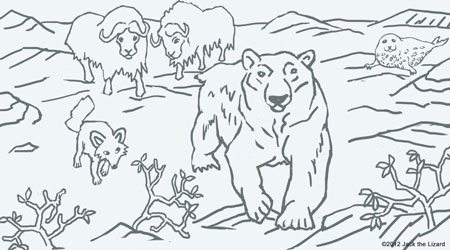
|
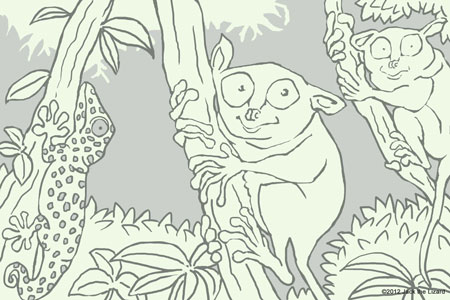
|
|
|
Great North Mammal - Polar Bear - Polar Bears live in the Arctic region. Their meals are mostly ringed and bearded seals. They have strong scent and can locate seals from a mile away. The hunting opportunity is the when seals come to the surface at the ice edge or the holes to breathe. Therefore they need sea ice to capture seals, although they are good swimmers. Polar bears also feed on a variety of animals such as beluga whales, walruses, muskoxen, reindeer and other polar bears. They also chew on the carcass of whales. Arctic foxes scavenge leftover or the dung of Polar bears. The fur is getting creamy yellow when polar bears get older. Sometimes the fur turns to green when the algae grow inside the coat. In fact the coat of Polar bears is transparent and the skin under it is black to absorb warm sunbeam. |
Small Big eyes primate - Tarsiers - Tarsiers are unique primates whose habitat is limited area of islands of Southeast Asia. The origin of tarsiers can trace back to early in the Eocene period. Remarkably they have not changed much their form since then. The distinctive feature of tarsiers is large eyes. They also can turn their head more than 180 degrees, like owls do but no other mammals cannot. Unlike other primate they communicate each other by the scent instead of visual or vocal. They only eat meat, so they are only primate that is carnivore and insectivore. |
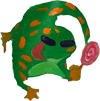
Jack the Lizard |
For the print size image, click |
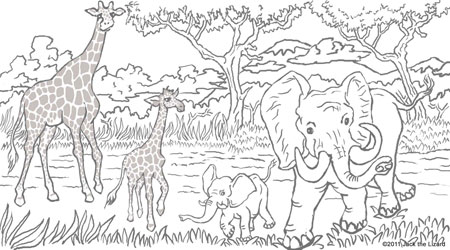
|
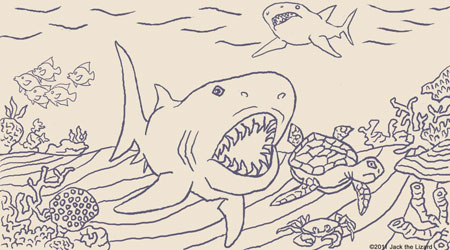
|
|
|
African big baby - Elephant and Giraffe Mother African elephant has her baby for a long time in her belly. It takes 20 to 22 months for mother to give birth to a baby. Baby elephant is about 35in (90cm) high and weighs over 220lb (100 kg) when it was born. For about 3 to 5 years a baby depends on mother’s milk. Baby giraffe is also large when it was born, about 5.9 to 6.5 ft (1.8 to 2m) high. Mother giraffe give birth to a baby or rarely twins after 13 to 15 months pregnancy. Baby giraffe suckles mother’s milk for about 13 months and stays with mother for another 2 to 5 months. African elephants have relatively long life for about 70 to 75 years. On the other hand the longevity of giraffes is about 25 years. |
Shell crusher - Tiger Shark Tiger sharks seem staying in warm water region of the world oceans. They swim in deep water, but often come into shallow area such as coral reefs and river estuaries. Young tiger sharks have strips from which the name “tiger” is derived on their body. The average size is about 12 feet (3.6m) and females are larger than males. Hunting time is usually during the night. Tiger sharks have electroreceptor with which they pick up the electricity emitted from prey on their body and eyes can detect prey in poor light. The diets include bony fish, crabs, lobsters, sea snakes, marine mammals and sea turtles. Tiger shark jaw is powerful enough to crush the carapace of turtles. They eat almost anything they can swallow. Tiger sharks assault humans; the frequency is only second to great white sharks, so they are hunted. Tiger sharks are also killed for its fin, meat and liver which contains vitamin A. |
|
For the print size image, click |

Jack the Lizard |

|

|
|
|
Danger sky high - Meerkats Family Meerkats are alert to predator from sky and ground. The danger from the air such as martial Eagles, vultures and hawks can seize an adult meerkat. Jackals and serval cats are threats on the ground. Even in their underground burrow badgers and cobras can sneak into and assault on them. Although cobras have strong venom, meerkats are quick enough to avoid its fang and sometimes counterattack a cobra if they have enough number of gang members. Lappet-faced Vulture is one of the largest among the African vultures. They can penetrate tough hides of the carcass and tear muscles. Smaller birds cannot do that and often take benefit after Lappet-faced Vultures finish their meal. Lappet-faced Vultures are also hunter while the other vultures usually eat remains of dead animals. Flamingos and small mammals are the targets of Lappet-faced Vultures. |
Lion Cubs African Lion cubs are born blind. Female lions give the birth a litter of 1 to 6 cubs. They weigh less than 5 pounds (2.3kg) and about 1 foot (30 cm) long. Their eyes open in about 2 to 3 weeks. After several weeks female and her cubs join their pride. Although all pride members take care new born cabs, most cubs, about 80 %, cannot reach the age of 2. In addition to disease and starvation, other predators such as hyenas, leopards and snakes kill cubs. Not only predator kill cubs, buffaloes also stamp cubs dead in order to clear future threats. When a new male lion takes over the pride, he also kills cubs to have his own offspring. The life of king of Africa is hard indeed. |

Jack the Lizard |
For the print size image, click |

|

|
|
|
Central American Wildlife The Eyelash viper is a venomous snake living in Central and South America. This viper has golden yellow skin with black spot. But some of them have mottled green, brown or grey. The habitat is trees in rainforest. Eyelash vipers are nocturnal ambush predator hunting frogs, lizards, rodents and small birds. The Fork-tailed Emerald is a hummingbird found in Central America. The color of body and wings is brilliant emerald green. The tail is white and beak is light red. The Heliconia is the plant with brilliant red flower. The Red-eyed Tree frog also lives in rainforest of Central America. The eyes are black pupil with red iris. The body is light green and the flank is dark blue with yellow lines. The hands and feet are orange. The forearms and thighs are dark blue. This frog eats insects such as crickets, moths and flies. The Northern Tamandula ranges from Mexico to Venezuela and Northern Peru. The habitats are forests and lowland forests. Ants and termites are main menu of their diets. They also eat bees and beetles. The grey parts are black and rest of parts are cream white. The Chestnut-mandibled Toucan can be found from Honduras to Ecuador. The grey parts are black. From upper parts of beak to chest is light yellow and legs are light blue. Lower part of beak is dark red. There is red triangle at the tail. They mostly eat fruits on trees, but also hunt insects, frogs, lizards, and small birds. Usually they live in the flock of two to ten birds. The shell is black or dark brown. The legs and bottom of the necks are yellow ocher with black mark. Black River Turtles live in Central America. They eat fruits and insects. Coloring of Central American insects is here. |
Malaysian Birds The bird with large crest eating a mangosteen is a great hornbill. The great hornbill lives in the forests of India, Indonesia and Malaysia. The size is about 75cm (30in) to 105cm (42in) long. Great hornbills eat mostly fruits, but also their diets include insects, lizards, snakes, birds and small mammals. The grey parts of this bird are black. White stripes on the wing and tail. White also covers under beak, the neck and legs. Orangey Yellow covers the crest, upper part of the beak, head, and feet. There is a red circle around the eyes. There is a male Asian fairy bluebird under the great hornbill. The grey parts are black and rest of the parts are brilliant turquoise blue. The eyes are black surrounded by dark red circle. Asian fairy bluebirds range over from the Himalayan foothill to north east India and Southeast Asia. The size is about 25cm (10in) long. They eat fruits and insects. Black naped orioles spread over Asia from Siberia to Korea and East Asia. In winter they migrate for breeding to South Asia. They can be found forests, woodlands and also parks and gardens. The diets are fruits, plants, and nectar. They also intake insects and small birds. The size is about 25cm (10in). A male has black mask on the eyes and black stripes on the wings and tail over brilliant yellow feather. The feet are also black. (all grey parts indicate black) The beak is pink and eyes are dark red. |
|
For the print size image, click |
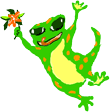
Jack the Lizard |
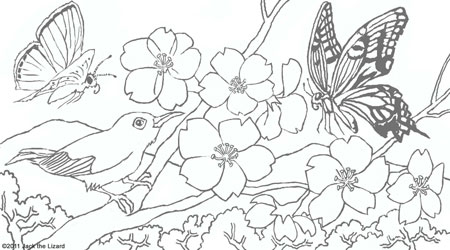
|
Wild Gastronome Cherry blossoms attract not only humans but animals too. Somei-yoshino is one of the most popular cherry in Japan. The Japanese White-eyes is a small bird flitting about among the flowers to drink nectar in early spring. Its wings are moss green and belly is grey. As distinct feature of this bird, there is the white circle around its eyes. Short-tailed Blue and Asian Swallow tail are butterflies can be observed from March to October in Japan. A male Short-tailed Blue has blue on its upper side wings and a female has dark brown. Both of them have white with black spots and 2 to 3 orange marks on the edge of underside wings. Asian Swallow tails have cream with black stripes on their wings. There are orange and blue spots on the edge of their back wings.
|

Jack the Lizard |
For the print size image, click |

|
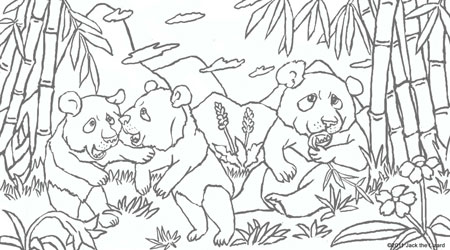
|
|||||||
|
Spring is sure to come These flowers are all spring flower. The flowers at front are Anemone hepatica in the buttercup family. The ones under right are Japanese primrose and rest of them are rapeseed flowers. Anemone hepatica blooms early spring. Since it tells arrival of spring, in Japan it is called “Yuikiwari-sou” (means “snow breaker”). Its flower has several colors such as white, blue and red. The colors of Japanese primrose are pink or white. Although it is found on grasslands and wetlands of Japan, it is also grown as gardening flower. Rapeseed flower is very popular flower in Japan. When bright yellow flowers bloom, the field of rapeseed turns to yellow carpet. Its leaves are also spring delicacy.
|
All Panda needs is Bamboo Giant Pandas eat bamboo. Almost all their meal is bamboo. But they are carnivore. Occasionally they eat meat such as rodents and carcass. An adult giant panda can eat up to 40kg (88lb) of bamboo per day. As carnivore their body adapt to digest meat, not plant. Since they only get small portion of nutrition, about 20%, from food, they need lots of bamboo to survive. Consequently they spend 12 to 14 hours a day on foraging and eating. 
|
|
For the print size image, click |

Jack the Lizard |
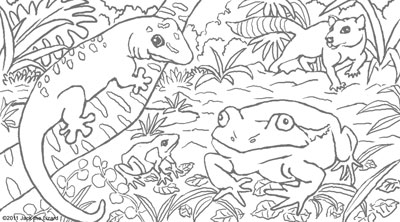
|
Madagascar Color
Madagascar Tomato frogs live in the Northeast of Madagascar. The habitats are rivers, ponds, canals, wetlands and moist forest. They hide during the day and hunt insects at night. The size is about 10cm (4in). They discharge toxic sticky substance when the predators such as snakes and cats bite them.
Painted mantella is one of the species of mantella frogs. Mantella frogs are also only found in Madagascar. They are small frogs about 2.5 to 5cm (1 to 2in). Their colors vary in species, some of them come with mixture of black, blue, yellow and green, depend on what they eat. Mantella frogs are very vulnerable to environmental contamination. Therefore some of them are listed in critically endangered species. |
|||
Madagascar day gecko is the one of the largest day geckos. It can reach about 30cm (12in) long. They eat insects, fruits, pollens and nectars. They have reddish orange spots on their back. Ring tailed mongooses are relatively small mongoose, head and body is about 32 to 38cm (12.5 to 15in) long. The tail is almost as long as it’s body. The diets of Ring tailed mongooses are small mammals, reptiles, fish and fruits. They also hunt lemur. |
||||

Jack the Lizard |
For the print size image, click |

|
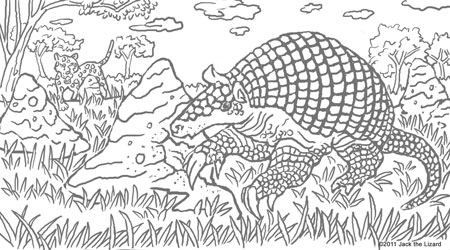
|
||||
|
Colorful Rainforest Bird - Macaw -
Blue and yellow macaws belong to the family of New World parrots. They live in Central and South America. The size is about 63 to 90 cm (25 to 36 in). The habitats are rainforests, swamps and near rivers. They are likely to gather in flocks of hundred or more birds. The foods are fruits, nuts and seeds. They are herbivore. This bird is trying to eat the fruit of acai palm of which color is dark purple.
Scarlet macaws also live in Central and South America. The size is slightly larger than Blue and yellow macaws. Both macaws lick clay at river bank to get mineral and salt. Scarlet ibis eat the variety of foods such as crabs, frogs, small fish and insects. Their color is from those foods. The size is about 56 to 76 cm (22 to 30 in). |
Gigante Shy Giant armadillos are the largest in the armadillo family which includes around 20 extant species. The length is about 88cm (35in) and the weight is around 30kg (70lb). They live in South America, from northwestern Venezuela to northeastern Argentina. The habitat is varied, near water in grassland, woodland, brushland and forest. Giant armadillos dig the burrows and live in to avoid predator. During the day they sleep and start foraging at night. They eat termites, ants, worms, mice and fruits. Their natural predators are jaguar and puma, but humans are the most threat to them. People hunt them for food and their skin. 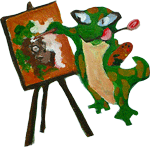
Jack the Lizard |
|
For the print size image, click |

Jack the Lizard |
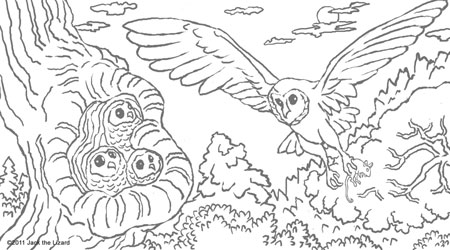
|
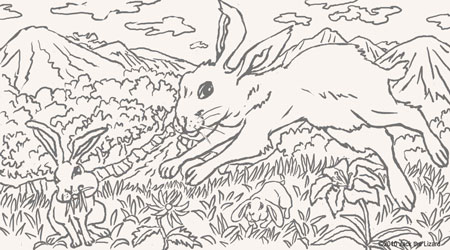
|
|
|
Barn Owl hunt in the Dark Barn owls are found in North and South America, Africa, Europe, Arabian Peninsula, Indonesia and Australia. They live in plains, grassland and woodlands. Hunting usually starts at dusk and continues on during the night. The main prey is rodents such as mice, rats and voles. They also eat birds, reptiles and insects depend on the environment of their habitat. The size is about 30 to 40cm (13 to 16in) in length and the wing span is about 100 to 125cm (39 to 49 in). The face is white and the body is white with little black spots. The upper part of the wings has varied colors such as black, grey, brown, orange and yellow. The inside of the wings is white with black broken stripes. |
Rabbit, hare and floppy ear There is one rabbit which does not inhabit this environment. The one with floppy ears called lop is a domesticated rabbit. So it lives in a house. One of the rests eating grass is a white-tailed jackrabbit and another one is an eastern cottontail rabbits. Rabbits are different from hares or jackrabbits. Rabbits are born blind without fur. On the other hand, baby hares has far and can see. While rabbits live in groups, hares usually have solitary life. The diets of rabbits and hares are plants such as grass, weeds, twigs and bark. They also eat their own droppings to extract remaining nutrition in it. Their large ears help them to detect presence of predator such as coyote, fox and owls while they are eating. |

Jack the Lizard |
For the print size image, click |

|

|
|
|
Amphibious life - Hippo - Usually mother hippo gives birth to only one baby under water. Since baby hippos cannot hold their breath under water for a long period of time, they often stay on their mother’ backs to rest. However baby hippos can take a deep breath when they swim under water to suckle. Mother hippos are terribly aggressive toward predators such as crocodiles, lions and hyenas and even humans to protect their babies. Hippopotamus means “river horse” in ancient Greek. But Hippos are closely related to whales rather than horses. |
One and only - Platypus - The Platypus lives in eastern Australia and Tasmania. Their habitats are the bank of rivers and freshwater lakes. They dig deep burrows for resting and nesting in those banks. Most active time is after dusk and before dawn. They shut eyes and noses while they are swimming, but do not have any difficulties to catch prey because they have electroreceptors on their bills. Their diets are aquatic insect larvae, worms, shrimps and freshwater crayfish called “yabbies”. Males have venomous spikes behind legs. The venom can cause severe pain in humans and kill small animals. This unusual look duck-billed animal is very rare species of mammal, called monotreme. The family of monotremes includes only five mammals, the platypus and four species of spiny-anteater. Uniqueness of monotremes is that they do not give birth to babies but lay eggs. The life span of Platypus is not for sure. The longest record in captivity is 17years. |
|
For the print size image, click |

Jack the Lizard |

|
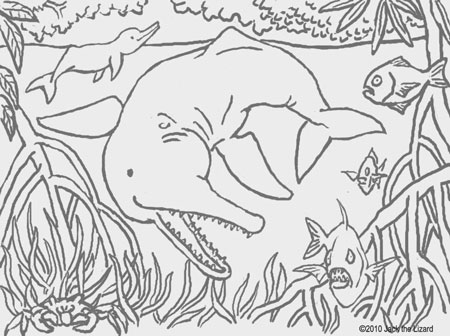
|
|
|
GLT and Fruits Golden Lion Tamarins live in the coastal lowland rain forest of south eastern Brazil. In the wild there are only about 1000 left. They eat fruits, insects and small animals such as lizards, mice and birds. The threats are snakes, ocelots and owls. But the habitat loss is the worst disaster for Golden Lion Tamarins to face. They are active during the day and spend most of their time above the forest floor. Jabuticaba Canistel Surinam cherry Cashew Jackfruit |
Amazon River look around Amazon River dolphins live in Amazon River and Orinoco River. They eat shrimps, crabs, small turtles, catfish, piranhas and other small fish. Male dolphins grow up to about 8.5ft (2.6m) and 400lb (180kg) in weight. Some of them turn their skin color from grey to pink when they become adults. So they are called pink dolphins as well. Another peculiarity of pink dolphins is that their necks can turn 180 degrees. During the rainy season since Pink dolphins have such flexible necks, they can slip themselves among tress in flooded jungle to find prey. |

Jack the Lizard |
For the print size image, click |

|

|
|||||||
|
Bugs and Roses Insects are very important components of a rose garden. Some of them are in fact pests which eat leaves and flowers but others are predators of those. For instance plant lice are very annoying insects in gardens, but lady beetles, crab spiders and some wasps feed on them. Some insects such as bees and flower chafers are agents for pollination between male flowers and female flower. Unfortunately crab spiders and other bugs eat bees. Using pesticide is easy way to kill off those bugs, but bees and flower chafers also die. Although a garden is manmade, it will become naturally balanced ecosystem with pests and beneficial insects. Then roses will be in full bloom.
|
Speed is life - Cheetah- Top speed reaches about 110km/h (70mph), while the cheetah is chasing prey. Unlike other big cats the cheetah has semi-retractable claws which give a hard grip on the ground. The diet of cheetahs is varied, but most of them are mammals under 40kg (88lb) such as Thomson’s Gazelles, Springboks, Impala, Warthogs and hares. Sometimes they take down larger prey like a wildebeest or a zebra when they hunt together. After successful hunt the cheetah must eat a kill as soon as possible, otherwise other predators such as lions, hyenas, leopards or even baboons intercept it. |
|
For the print size image, click |

Jack the Lizard |

|
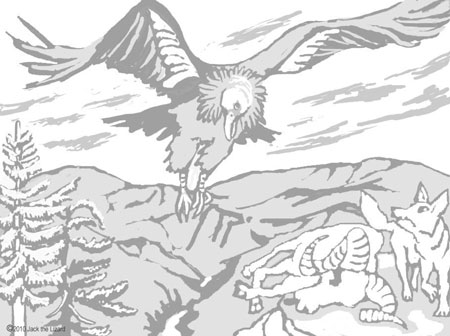
|
Giraffe chewing Giraffes live in Africa. The size is approximately 4 m (14 ft) to 5 m (16 ft) tall and weighs about 600 kg (1300 lb) to 2 tons (4400 lb). There are 9 subspecies of Giraffe. Each of them has unique pattern of colors. Giraffe eat leaves, grass and fruits. Especially several kinds of Acacia trees are their favorite. Although Acacia has sharp thorns on its twigs, the tongue and the lip of Giraffe are tough enough to bear. Giraffe can munch up about 29 kg (65 lb) of leaves and twigs a day, but it is not necessary to take them so much. Giraffe chews food many times in order to extract t as much nutrition as possible. So Giraffe can survive dry season. Lions are only threat to adult giraffe. But even lions have to be cautious when they attack a giraffe. Because the kick of giraffe is so powerful that it can smash the skull of lion. Amazingly giraffes sleep only between ten minutes and 2 hours in a 24 hour period. They live up to 25 years in the wild. The calf and mother in this coloring page are Masai Giraffes which inhabit Kenya and Tanzania. Masai Giraffe has dark brown spots on yellow coat. The tongue is dark purple. |
Flying High - California Condor – The population of California condor is about 180 in the wild and 163 in captivity. California condors live in the coast of southern California, the Grand Canyon of north Arizona and Baja California in Mexico. They favour staying at the area of mountains and ravines, which creates updraft they can use to sore and glide. The nesting sites are often found in caves and crevices on cliffs or hillsides. California condors clean up carcasses of animals such as deer, goats, horses, rabbits, cougars and bears. They also eat the carrion of marine mammals such as whales and sea lions. Searching for food extend up to 160miles (250km). The wing span is about 9.6ft (290cm) and weighs approximately 29lb (13kg). They live up to 60 years. The bill is light grey and the face is pink, yellow or orange. The eye is black pupil and dark red. The wing and body are black. There are white patches underside of the wings. The recovery plan is successful so far, but there are still threats. Some of them died from the collision with manmade construction and food poisoning from eating lead contaminated carcasses. |

Jack the Lizard |
For the print size image, click |
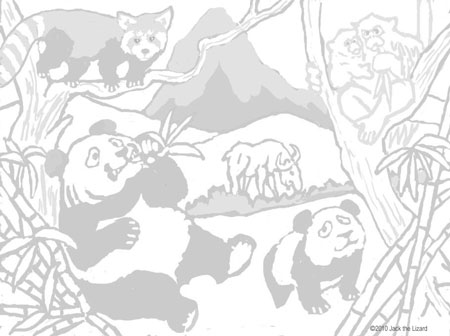
|

|
|
|
Panda country The habitats of giant panda are the mountains of three provinces, Sichuan, Shaanxi and Gansu in China. Those mountains are also homes for some of the rare animals in the world such as Golden Snub-nosed Monkey, Takin and Red Panda. Golden Snub-nosed Monkeys live together with their family. The family group has about 10 to 20 members or sometime several hundred depend on climate and food availability. They are active during the day and spend most of their time on trees. The diets are mainly lichens, but they also eat bark, leaves, fruits and seed. In winter snow covers mountains for months but they can resist cold temperature with their thick long coat. Golden takin is goat-antelope and listed in endangered species. One of their features of the thick short legs can get over steep slope of mountain area. Golden takins form small herds. They eat leaves, buds, bark and bamboo. They are adapted to harsh winter with their thick coat and oily skin. Their long snouts also help warming up air before reaching their lung. Red panda need lots of bamboo leaves and shoots a day. Since red panda mostly eat bamboo which contains not much nutrition, red pandas use food energy very effectively in their body. They also forage fruits, flowers, fungi and seeds. Occasionally eggs, small birds and rodents are also in their diets. All species are losing their habitat because of deforestation and developments. More Giant Panda Colloings are Here and Here. |
Wildlife in Alaska Alaska has the most Brown bear population in North America. They live in every part of Alaska except a few islands. Brown bears in Alaska are divided into two groups, grizzly bears and Kodiak bears. Grizzly bears are commonly found and Kodiak bears are only found in the Islands of Kodiak Archipelago. Kodiak bear is the largest brown bear in the world. The male is about 3 m (10 ft) long and weighs about 680 kg (1500 lb). Moose in Alaska is also enormous. The male stands about 2 m (7 ft) tall at the shoulder and about 720 kg (1600 lb) in weight. Moose feed on plants and fruits. The full-grown adults are not often attacked by predator, but calves, young and mothers are. The population of moose is controlled by predator such as wolves, bears and humans. In Alaska North American river otters eat fish, frogs and insects. In water they can swim fast and flee from predator, but they have to be more careful in land. Various animals prey on them such as Black bear, Grey wolf, Coyote, Red fox, Mountain lion and Bobcat. North American river otter live in diverse watery environments, including rivers, lakes, wetland, marshes and sea shore. |
|
For the print size image, click |

|

|
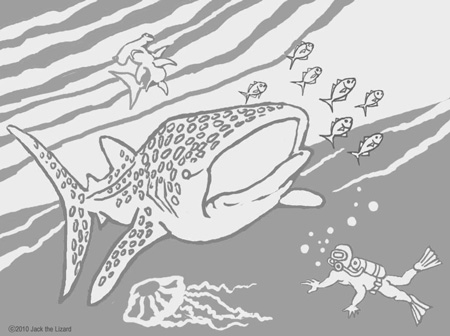
|
|
|
Philippine Sailfin lizards are living in the tropical jungle of Philippine islands. They are often found closed to rivers and streams. Since swimming is the specialty of them, they can escape from danger to dive into water. The size of adult lizard is about 1 m (3 ft). The body is dark green and the belly is light yellow. The males have violet color on the crest, the sail and face. They eat leaves, flowers, fruits and insects. Tiny primate clinging to a branch is a Philippine Tarsier. The Philippine crocodile is endemic in Philippine and critically endangered species. The main threat now is habitat loss. |
The Ocean is vast. You cannot tell what you are going to discover next. The Whale shark is the largest fish known so far, which is about 12 m (40 ft) long and probably grows more. The lifespan may reach to over 100 years. By the way the Basking shark is the second largest fish. Whale sharks are swimming around in all tropical and warm temperature oceans except the Mediterranean Sea. They are usually found in the high seas, but some reach to coasts. They eat mainly plankton with filtering. The tiny teeth, which are on the gill and the throat, catch plankton and small animals such as krill and schooling fish while draining out water through the gill. The upper part of the body is grey with creamy white spots. The belly is white. They are gentle shark and can swim with divers no problema. |

|
For the print size image, click |

|
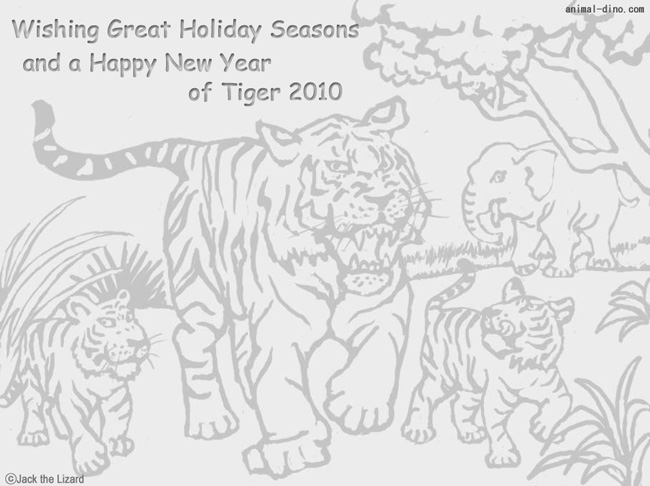
|
|
|
Burrowing owl The range of Burrowing owls is from West-central Canada to South America. They are also found in Florida and Caribbean Islands. The habitat is dry short –grass prairie. They are relatively small owls; the size is about 25 cm (10 in). The long slender legs are a characteristic of this bird. The upper parts of wings and head are brown with white spots. The body is yellowish white base with light brown fleck. The eyebrows are white. The eyes and beak are yellow. The nest of burrowing owl is a den abandoned by small mammals such as prairie dogs, ground squirrels and badgers. To avoid midday heat, burrowing owls go hunting at sunrise and sunset. They eat insects, lizards, frogs, birds and mice. |
let's print this out. |
|
For the print size image, click |

|

|

|
|
|
Bull elephant walks Lions do hunt an elephant, but they aim at young or weak one. Full grown bull elephant is too powerful for lions to attack. Even male lions will be nervous if they are beside an angry bull elephant. |
Bobcat blues Bobcats range from southern Canada to southern Mexico. The other wildcats, Canadian Lynxes are similar to Bobcats, but they are larger and have thicker limbs than Bobcats. Canadian lynxes need dense forest to survive; on the other hand Bobcats accommodate themselves to several environments such as woodlands, swamps, desert and agricultural area. The coat of Bobcats is tan or grayish brown with black spots on the body and stripes on the forelegs. The size is about 70 to 105 cm (28 to 41 in) in length. They hunt hares and rats, but also eat small animals such as birds, fish and insect. The selection of the menu depends on the availability. |

|
For the print size image, click |

|

|
|
|
Orca The Killer Whale or Orca is a member of the dolphin family. You can find Orcas in all the oceans of the world. Although only one species is recognized as the Orca, it can be divided by the diet, the distribution and the appearance. In North America there are three groups of orcas. First ones live in family and feed on mainly fish such as salmon and herring. They are observed in British Colombia, Canada, Washington, U.S.A. and Alaska. The second hunt only marine mammals including sea lions, elephant seals, walruses and even large baleen whales such as Mink whales and Gray whale. They travel from Alaska to California. They usually live in small groups. The third live in open Ocean and eat fish. They form large groups up to 100. Each group has different patch patterns or shapes of dorsal fin. Some Orcas Attack even large sharks in other part of the world but never humans. |
Brown Bear Seasoned Brown bear cubs born in January or February and emerged from winter den in April or May. Until then they depend on her mothers' milk. Brown bears are omnivores, so they feed on wide range of food. Some brown bears eat variety of berries, leaves, flowers, roots, fungi and some prefer insects or animals. The diet is varied because of the food availability which changed by the habitat. Cubs must learn important survival skills, such as where to find edible vegetation, how to hunt, how to fish, how to avoid predator and where to den. They absorb those by watching and imitating their mother for about 2 to 3 years. Total population of Brown bear is approximately 200,000 in the World. Mainly they inhabit countries such as Russia, U.S.A., Canada, Romania, Bosnia-Herzegovina and Finland. |
|
For the print size image, click |
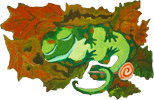
|

|
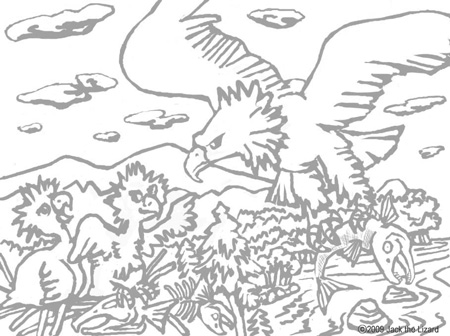
|
|
|
Harp Seal The Harp Seals live mainly in three areas, the White Sea in Western Russia, The West Ice around Greenland and the Northwest Atlantic off Canada. They migrate for about 4,000 km to chase after food except breeding seasons. The main foods are fish like cod and crustaceans such as shrimps and krill. The babies are born in late February. The pup is covered with white fur, unable to swim. After the birth, the mother seal stays with her pup to feed for about 12 days, then she disappears. The pups need about 4 weeks to learn swimming and hunting by themselves. So it is very vulnerable to attack by the predators including polar Bears, Orcas, Walruses or human hunters. The pups hide themselves behind a chunk of ice. The white fur helps the pup to blend well with the snow and ice. |
Bald Eagle depend on fish The habitat of Bald Eagle spreads out throughout North America. Bald Eagles mainly eat fish such as salmon and trout, so they live near seashore, rivers and lakes. They also eat carcass of animals if those were available. Bald Eagles migrate if they cannot get sufficient food during the winter. The grown has white head and tail. The feature of adult is also yellow beak and irises. The juvenile is completely brown except feet. The chick has white body with black beak. Bald Eagle is the national bird of U.S.A. and sacred for all people. Do you want to watch the photos of Bald Eagle? Click HERE! |

|
For the print size image, click |
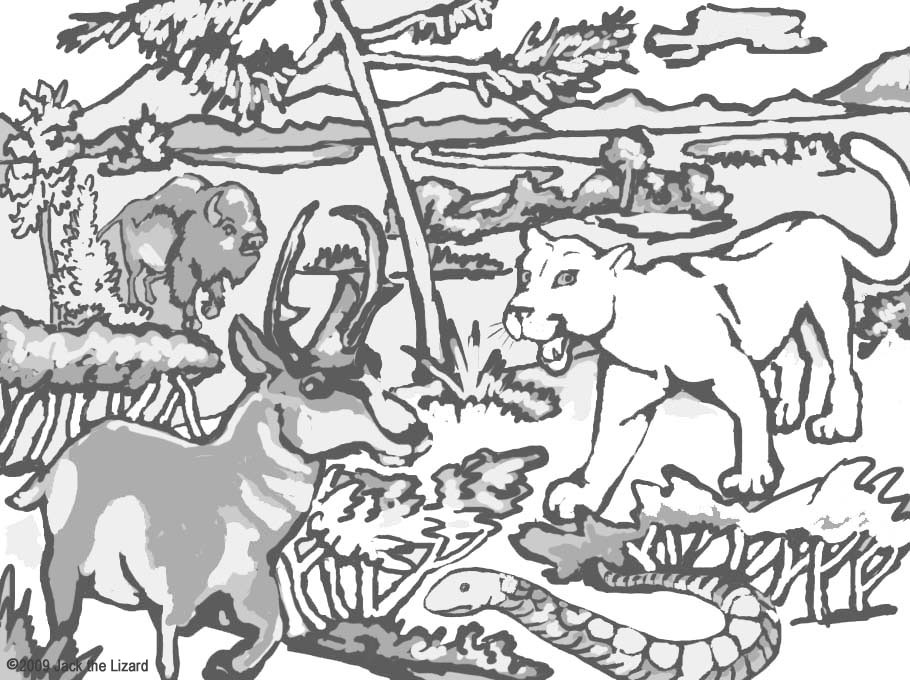
|

|
|
|
The Park for animals Yellowstone National Park is in the state of Wyoming, U.S.A. It also covers part of Montana and Idaho. The variety of North American Wildlife lives in the Park. Mountain lion is one of them. The color is Yellow ocher but the tip of nose, the chin and the abdomen are white. A male Mountain lion is about 8 ft (2.4 m) long. A Female is smaller. In the Yellowstone National Park they eat elks, mule deer, pronghorn and small mammals such as mice, porcupine and hares. Pronghorn is a fast runner. The speed reaches up to 50 miles per hour (80 km per hour). The length is about 5 ft (1.5 m). The most part of body is reddish brown except the hip, the abdomen, the flank and the chin are white. It also has white stripes on the neck. The Bullsnake is not venomous. The average length is about five feet. The color is yellow with brown or black blotches along the body. Bullsankes eat mice, lizards, insect, and birds. Young ones are vulnerable to raptors and skunks. American Bison was once the verge of extinction. Now they are back. Bison usually live with herd. He is probably lost and looking for his family. Do you want to watch the photos of Pronghorn? Click HERE! |
Sea Otters Sea otters lives along the coast of California, Alaska, the Aleutian Islands and Hokkaido in Japan. They mainly eat animals lives on sea floor such as sea urchins, molluscs and crustaceans. The Giant kelp which is large seaweed provides the place to hunt and hide to sea otters. They can also rest without drowning by the current by wrapping themselves with kelp. It is also very important for otters to keep cleaning their fur which protect them from cold temperature. 
|
|
For the print size image, click |

|
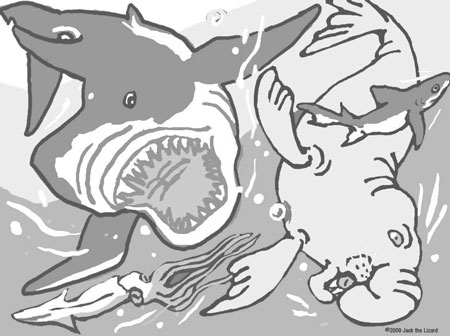
|
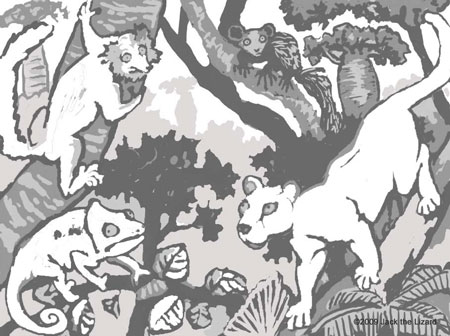
|
|
|
Great white shark is not the strongest The range of Great white sharks is wide. They live coast of North and South America, Mediterranean, South Africa, Australia, New Zeeland and Japan. The large one is about 6m (20ft) long and weighing about 2000kg (4400lb). They are certainly fearsome creature but not the strongest in the ocean. Bottlenose Dolphins poke the abdomen of Great white shark to protect their babies. Great white sharks could be fatally injured by that attack because they do not have the hard bones to protect the internal organs. Orca mother also does not want sharks around when they are with babies. The ocean is dangerous world even for Great white sharks. In the coast of California they attack Northern Elephant Seals. A male is about 4m (14ft) and 640kg (1400lb), so Northern Elephant Seals are not easy meal. They also eat seals, sea lions, tunas, rays and sharks. |
Fossa Fossa is not a cat. The relative of fossa is the Mongoose. Although fossa is not a large, 80 cm (32 in) in length excluded tail, it is top predator of Madagascar. The body color is reddish brown, but the belly is white. Black lemur is one of the diets of Fossa. Only male is black. Female has yellow eyes and black face with white whiskers. The body and tale are golden brown, but only hands are black. Aye-aye is nocturnal primate. The far is black with scattered grey hair. Chameleon is the Ninja. It blended into the surroundings. |

|
For the print size image, click |

|

|
|
|
The Smooth Japanese Bun Crab The Smooth Japanese bun crab is a species of red reef crabs. The shell is about 5cm long (about 2 inches). The body color is red wine with grey patch. This small crab has venom which is strong enough to kill a person in its muscle. You usually see Yellow Longnose Butterflyfish around coral reefs. Batfish (platax teira) have black striped light grey body. Blue humphead parrotfish sleeps while covering itself with mucus during the night. The meat is edible, but guts of this fish contain venom. The common Octopus is like a chameleon of the sea. Crabs and shrimps are prey to this octopus. Clownfish acquire the immune to the poison of sea anemone when they are young. Please do not forget the blow fish above the Manta ray |
Insects' Paradise Costa Rica has the highest density of biodiversit of the world. Let's see the beautiful insects in the rainforest. The Hercules Beetle is the largest rhinoceros beetle. The forewings are in dark yellowish green like green olive, the horn, head and legs are in dark brown and the hair under the horn is in orange. Marcella Daggwerwing is a beautiful butterfly found in the Central America. The part in shadow is in brown, the white triangle shape close to the body is in purple, the other part is in orange. The Leaf Mantis mimics the leaves around him. Another butterfly underneath of the Hercules Beetle is the Prepona. The part in shadow is dark purple, and the white part is in shiny blue. Coloring of Central American wildlife is here. |
|
For the print size image, click |

|

|
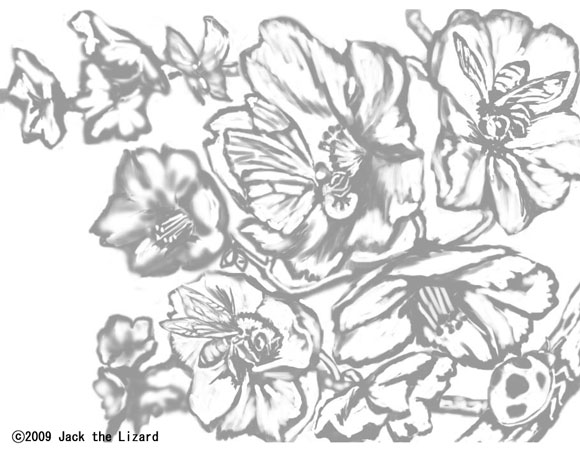
|
||||||||||
|
Dry Season Giraffes can take water from their favorite twigs of acacia tree. So they don’t need drink water for 2 to 3 days. But when they are really thirsty, they drink up 40 little of water at once. African Elephants come to water side and bathe to cool themselves down and remove any dirt or parasites from their skin. Hippopotamuses need to keep their skin moist, so they are in or around the water most of the time. Lions need to drink a lot of water, too. They also get hydrated from their preys, or tsamma melon. Dry Season is a very challenging season to survive for any animals. |
Blooming Season Flowers start blooming in early spring. Their colors and sweet aroma are fascinating for not only us humans but also all the animals, birds, and insects. By the way, the Arctic Bumblebee habitats in the arctic regions. In Ellesmere Island in Canada, the bees collect nectar from arctic plants during the short summer. The bees have a very important roll of pollinating other plants in the area while they are hovering over from flower to flower. During winter, they stay close together to keep their body temperature in their colony. Their amazing behaviour is that they can regulate the body temperature by shivering their abdominal and chest muscle to warm up their bodies.
|

|
For the print size image, click |
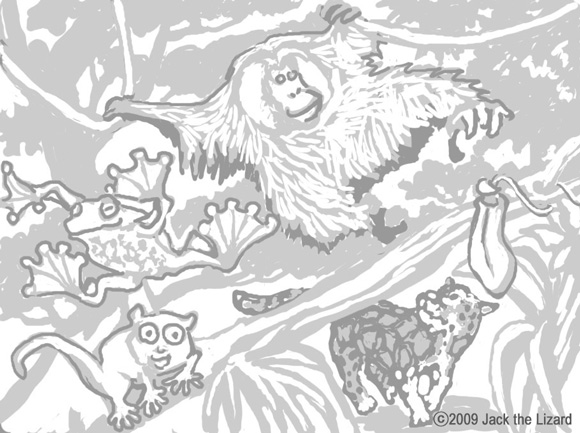
|
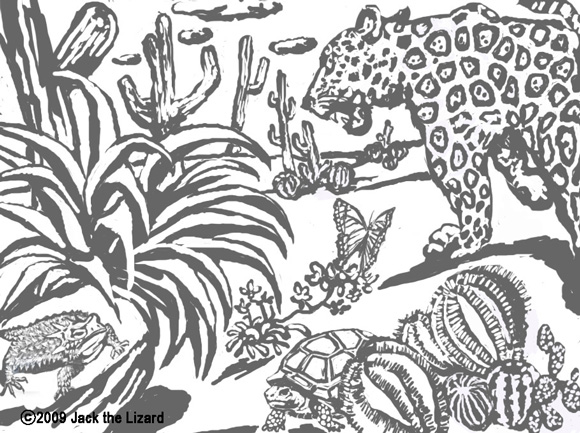
|
|
|
Borneo rain forest Borneo Orangutans mostly spend their time in the forest canopy. The female make a nest and even gives birth at a treetop. Western tarsier is also tree dweller. Big eyes and ears can detect subtle movement of insects at night. Flying frogs can glide between trees. Their back is green and abdomen is yellow with red wavy lines. The back of the hands and feet has red color. They have the webs between fingers and toes. There are also lateral flaps on the arms and the legs. Wild cat is the Bornean Clouded Leopard. The base color of coat is tawny and trapezoidal black lines are on it. All of them are in deep in the rain forest of Borneo Island in Indonesia. |
Desert Life Not in Zoo. Wild Jaguars do live in U.S.A. Although numbers are extremely low, they are roaming around Southern Arizona and New Mexico. In those regions there are deserts such as Sonoran and Chihuanhuan. Despite of harsh condition of desert, many animals dwell in and thrive. Because desert is not actually "desert". Especially Sonoran Desert has considerable rainfall as a desert. Desert Tortoises can survive on water from their diet such as flowers and grasses. In spring Horned Lizards wake up from hibernation. Ants are the mostly eaten food by Horned Lizards, but they also prey on other insect such as termites, beetles and crickets. |
|
For the print size image, click |

|

|

|
|
|
In the Jungle There are many animals in the tropical rainforest. The Plumed Basilisk is patiently waiting for his preys like bugs or spiders. The hummingbird has a purple face and green body. She stops by flowers one after another and carries pollen. There is a guy who has red eyes, green body, orange legs and blue and yellow strip in his side. He is called Red-eyed tree frog. Squirrel Monkey on the tree has dark brown head and yellow body. Her belly is white. Haven't you ever seen a Plumed Basilisk? Jack the Lizard took a picture of the one at London Zoo. Click Here!
|
Alpine meadow In early spring alpine meadow woodchuck (groundhog) has already woke up from hibernation. Least chipmunk also gets out of their winter den. In this picture only red fox does not hibernate because he has winter coat. As dangerous sleepy hungry bear is approaching, woodchuck is on high alert. Haven't you ever seen a woodchuck or a groundhog? Jack the Lizard took some pictures of those at Smithers, Blitish Colombia in Canada. Click Here! Do you want to know more about woodchuck? Click Here!! Here is a very interesting story about Bear's hibernation. Click Here!! |

|
For the print size image, click |
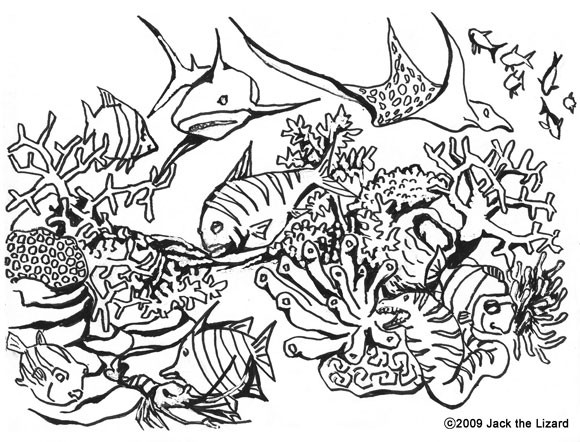
|

|
|
|
How many fish are around the coral? |
Water Buffalo is one of the preys of tiger. But it won’t be going down without fight. |
|
For the print size image, click |

|
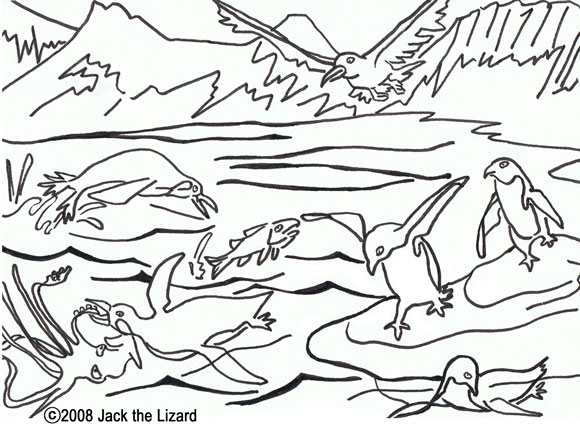
|

|
|
|
The Adelie Penguin and the Emperor Penguin, which is the biggest among the penguin family, live in the Antarctica. They eat fish, squid, and so on. You may see both of them at Port of Nagoya Public Aquarium. |
Koala |

|
For the print size image, click |
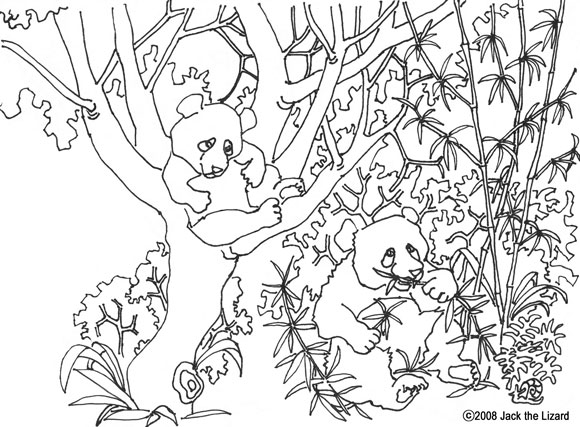
|

|
|
|
Giant Panda
More Giant Panda Colloings are Here and Here. |
Dolphin Another coloring of Dolhpin, click HERE! |
